Teka DW6 42 FI User Manual [pt]
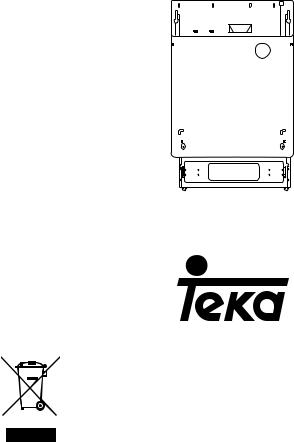
Use and Maintenance Manual Manual de Uso y Mantenimiento Manual de Utilização e Manutenção Manual d'Emploi et Entretien Bedienungsanleitung und pilegehinweise Istruzioni sull’uso
DW6 42 FI
Code: 0120505815

Index |
|
|
|
|
|
|
|
|
|
|
|
|
|
|
|
|
|
|
|
|
|
|
|
|
|
|
|
|
|
|
|
|
|
|
|
|
|
|
|
|
|
|
|
|
|
|
|
|
|
|
|
|
|
|
|
|
|
|
|
|
|
|
|
|
|
|
|
|
|
|
|
|
|
|
|
|
|
|
|
|
|
|
|
|
|
|
|
|
|
|
|
|
|
|
|
|
|
|
|
|
|
|
|
|
|
|
|
|
|
|
|
|
|
|
|
|
|
|
|
|
|
|
|
|
|
|
|
|
|
|
|
|
|
|
|
|
|
|
|
|
|
|
|
|
|
|
|
|
|
|
|
|
|
|
|
|
|
|
|
|
|
|
|
|
|
|
|
|
|
|
|
|
|
|
|
|
|
|
|
|
|
|
|
|
|
|
|
|
|
|
|
|
|
|
|
|
|
|
|
|
|
|
|
|
|
|
|
|
|
|
|
|
|
|
|
|
|
|
|
|
|
|
|
|
|
|
|
|
|
|
|
|
|
|
|
|
|
|
|
|
|
|
|
|
|
|
|
|
|
|
|
|
|
|
|
|
|
|
|
|
|
|
|
|
|
|
|
|
|
|
|
|
|
|
|
|
|
|
|
|
|
|
|
|
|
|
|
|
|
|
|
|
|
|
|
|
|
|
|
|
|
|
|
|
|
|
|
|
|
|
|
|
|
|
|
|
|
|
|
|
|
|
|
|
|
|
|
|
|
|
|
|
|
|
|
|
|
|
|
|
|
|
|
|
|
|
|
|
|
|
|
|
|
|
|
|
|
|
|
|
|
|
|
|
|
|
|
|
|
|
|
|
|
|
|
|
|
|
|
|
|
|
|
|
|
|
|
|
en |
||||||||||||||||||||||||||||||||||||||||||||||||||||||||||||||||||||||||||||||||||||||||||||||||||||||||||||||||||||||||||||||||||||||||||||||||||||||||||||||||||||||||||||||||||||||||||||||||||||||||||||||||||||||||||||||||||||||||||||||||||||||||||||||||||||||||||||||||||||||||||||||||||||||||||||||||||||||
Safety information |
|
|
|
|
|
|
|
|
|
|
|
|
|
|
|
|
|
|
|
|
|
|
|
|
|
|
|
|
|
|
|
|
|
|
|
|
|
|
|
|
|
|
|
|
|
|
|
|
|
|
|
|
|
|
|
|
|
|
|
|
|
|
|
|
|
|
|
|
|
|
|
|
|
|
|
|
|
|
|
|
|
|
|
|
|
|
|
|
|
|
|
|
|
|
|
|
|
|
|
|
|
|
|
|
|
|
|
|
|
|
|
|
|
|
|
|
|
|
|
|
|
|
|
|
|
|
|
|
|
|
|
|
|
|
|
|
|
|
|
|
|
|
|
|
|
|
|
|
|
|
|
|
|
|
|
|
|
|
|
|
|
|
|
|
|
|
|
|
|
|
|
|
|
|
|
|
|
|
|
|
|
|
|
|
|
|
|
|
|
|
|
|
|
|
|
|
|
|
|
|
|
|
|
|
|
|
|
|
|
|
|
|
|
|
|
|
|
|
|
|
|
|
|
|
|
|
|
|
|
|
|
|
|
|
|
|
|
|
|
|
|
|
|
|
|
|
|
|
|
|
|
|
|
|
|
|
|
|
|
|
|
|
|
|
|
|
|
|
|
|
|
|
|
|
|
|
|
|
|
|
|
|
|
|
|
|
|
|
|
|
|
|
|
|
|
|
|
|
|
|
|
|
|
|
|
|
|
|
|
|
|
|
|
|
|
|
|
|
|
|
|
|
|
|
|
|
|
|
|
|
|
|
|
|
|
|
|
|
|
|
|
|
|
|
|
|
|
|
|
|
|
|
|
|
|
|
|
|
|
|
|
|
|
|
|
|
|
|
|
|
|
|
|
|
|
|
|
|
|
|
|
|
|
|
|
|
|
|
|
|
|
|
|
|
|
|
|
|
|
|
|
|
|
|
|
|
|
|
|
|
|
|
|
|
|
|
|
|
|
|
|
|
|
|
|
|
|
|
|
|
|
|
|
|
|
|
|
|
|
|
|
|
|
|
|
|
|
|
|
|
|
|
|
|
|
|
|
|
|
|
|
|
|
|
|
|
|
|
|
|
|
|
|
|
|
|
|
|
|
|
|
|
|
|
|
|
|
|
|
|
|
|
|
|
|
|
|
|
|
|
|
|
|
|
|
|
|
|
|
|
|
|
|
|
|
|
|
|
|
|
|
|
|
|
|
|
|
|
|
|
|
|
|
|
|
|
|
|
|
|
|
|
|
|
|
|
|
|
|
|
|
|
|
|
|
|
|
|
|
|
|
|
|
|
|
|
|
|
|
|
|
|
|
|
|
|
|
|
|
|
|
|
|
|
|
|
|
|
|
|
|
|
|
|
|
|
|
|
|
|
|
|
|
|
|
|
|
|
|
|
|
|
|
|
|
|
|
|
|
|
|
|
|
|
|
|
|
|
|
|
|
|
|
|
|
|
|
|
|
|
|
|
|
|
|
|
|
|
|
|
|
|
|
|
|
|
|
|
|
|
|
|
|
|
|
|
|
|
|
|
|
|
|
|
|
|
|
|
|
|
2 |
||||||||||||||||||
|
|
|
|
|
|
|
|
|
|
|
|
|
|
|
|
|
|
|
|
|
|
|
|
|
|
|
|
|
|
|
|
|
|
|
|
|
|
|
|
|
|
|
|
|
|
|
|
|
|
|
|
|
|
|
|
|
|
|
|
|
|
|
|
|
|
|
|
|
|
|
|
|
|
|
|
|
|
|
|
|
|
|
|
|
|
|
|
|
|
|
|
|
|
|
|
|
|
|
|
|
|
|
|
|
|
|
|
|
|
|
|
|
|
|
|
|
|
|
|
|
|
|
|
|
|
|
|
|
|
|
|
|
|
|
|
|
|
|
|
|
|
|
|
|
|
|
|
|
|
|
|
|
|
|
|
|
|
|
|
|
|
|
|
|
|
|
|
|
|
|
|
|
|
|
|
|
|
|
|
|
|
|
|
|
|
|
|
|
|
|
|
|
|
|
|
|
|
|
|
|
|
|
|
|
|
|
|
|
|
|
|
|
|
|
|
|
|
|
|
|
|
|
|
|
|
|
|
|
|
|
|
|
|
|
|
|
|
|
|
|
|
|
|
|
|
|
|
|
|
|
|
|
|
|
|
|
|
|
|
|
|
|
|
|
|
|
|
|
|
|
|
|
|
|
|
|
|
|
|
|
|
|
|
|
|
|
|
|
|
|
|
|
|
|
|
|
|
|
|
|
|
|
|
|
|
|
|
|
|
|
|
|
|
|
|
|
|
|
|
|
|
|
|
|
|
|
|
|
|
|
|
|
|
|
|
|
|
|
|
|
|||||||||||||||||||||||||||||||||||||||||||||||||||||||||||||||||||||||||||||||||||||||||||||||||||||||||||||||||||||||||||||||||||||||||||||||||||||||||||||||||||||||||||||||||||||||||||||||||||||||||||||||||||||||||||||||||||||||||||||||||||||||||||||||||||||||||||||||||||||||||||||||||||||||||||||||||||||||||||||||||||||||||||||||||||||||||||||||||||||||
Installation |
|
|
|
|
|
|
|
|
|
|
|
|
|
|
|
|
|
|
|
|
|
|
|
|
|
|
|
|
|
|
|
|
|
|
|
|
|
|
|
|
|
|
|
|
|
|
|
|
|
|
|
|
|
|
|
|
|
|
|
|
|
|
|
|
|
|
|
|
|
|
|
|
|
|
|
|
|
|
|
|
|
|
|
|
|
|
|
|
|
|
|
|
|
|
|
|
|
|
|
|
|
|
|
|
|
|
|
|
|
|
|
|
|
|
|
|
|
|
|
|
|
|
|
|
|
|
|
|
|
|
|
|
|
|
|
|
|
|
|
|
|
|
|
|
|
|
|
|
|
|
|
|
|
|
|
|
|
|
|
|
|
|
|
|
|
|
|
|
|
|
|
|
|
|
|
|
|
|
|
|
|
|
|
|
|
|
|
|
|
|
|
|
|
|
|
|
|
|
|
|
|
|
|
|
|
|
|
|
|
|
|
|
|
|
|
|
|
|
|
|
|
|
|
|
|
|
|
|
|
|
|
|
|
|
|
|
|
|
|
|
|
|
|
|
|
|
|
|
|
|
|
|
|
|
|
|
|
|
|
|
|
|
|
|
|
|
|
|
|
|
|
|
|
|
|
|
|
|
|
|
|
|
|
|
|
|
|
|
|
|
|
|
|
|
|
|
|
|
|
|
|
|
|
|
|
|
|
|
|
|
|
|
|
|
|
|
|
|
|
|
|
|
|
|
|
|
|
|
|
|
|
|
|
|
|
|
|
|
|
|
|
|
|
|
|
|
|
|
|
|
|
|
|
|
|
|
|
|
|
|
|
|
|
|
|
|
|
|
|
|
|
|
|
|
|
|
|
|
|
|
|
|
|
|
|
|
|
|
|
|
|
|
|
|
|
|
|
|
|
|
|
|
|
|
|
|
|
|
|
|
|
|
|
|
|
|
|
|
|
|
|
|
|
|
|
|
|
|
|
|
|
|
|
|
|
|
|
|
|
|
|
|
|
|
|
|
|
|
|
|
|
|
|
|
|
|
|
|
|
|
|
|
|
|
|
|
|
|
|
|
|
|
|
|
|
|
|
|
|
|
|
|
|
|
|
|
|
|
|
|
|
|
|
|
|
|
|
|
|
|
|
|
|
|
|
|
|
|
|
|
|
|
|
|
|
|
|
|
|
|
|
|
|
|
|
|
|
|
|
|
|
|
|
|
|
|
|
|
|
|
|
|
|
|
|
|
|
|
|
|
|
|
|
|
|
|
|
|
|
|
|
|
|
|
|
|
|
|
|
|
|
|
|
|
|
|
|
|
|
|
|
|
|
|
|
|
|
|
|
|
|
|
|
|
|
|
|
|
|
|
|
|
|
|
|
|
|
|
|
|
|
|
|
|
|
|
|
|
|
|
|
|
|
|
|
|
|
|
|
|
|
|
|
|
|
|
|
4 |
|||||||||||||||||||||||||||||||||||||||||||||||||||||||||||||
|
|
|
|
|
|
|
|
|
|
|
|
|
|
|
|
|
|
|
|
|
|
|
|
|
|
|
|
|
|
|
|
|
|
|
|
|
|
|
|
|
|
|
|
|
|
|
|
|
|
|
|
|
|
|
|
|
|
|
|
|
|
|
|
|
|
|
|
|
|
|
|
|
|
|
|
|
|
|
|
|
|
|
|
|
|
|
|
|
|
|
|
|
|
|
|
|
|
|
|
|
|
|
|
|
|
|
|
|
|
|
|
|
|
|
|
|
|
|
|
|
|
|
|
|
|
|
|
|
|
|
|
|
|
|
|
|
|
|
|
|
|
|
|
|
|
|
|
|
|
|
|
|
|
|
|
|
|
|
|
|
|
|
|
|
|
|
|
|
|
|
|
|
|
|
|
|
|
|
|
|
|
|
|
|
|
|
|
|
|
|
|
|
|
|
|
|
|
|
|
|
|
|
|
|
|
|
|
|
|
|
|
|
|
|
|
|
|
|
|
|
|
|
|
|
|
|
|
|
|
|
|
|
|
|
|
|
|
|
|
|
|
|
|
|
|
|
|
|
|
|
|
|
|
|
|
|
|
|
|
|
|
|
|
|
|
|
|
|
|
|
|
|
|
|
|
|
|
|
|
|
|
|
|
|
|
|
|
|
|
|
|
|
|
|
|
|
|
|
|
|
|
|
|
|
|
|
|
|
|
|
|
|
|
|
|
|
|
|
|
||||||||||||||||||||||||||||||||||||||||||||||||||||||||||||||||||||||||||||||||||||||||||||||||||||||||||||||||||||||||||||||||||||||||||||||||||||||||||||||||||||||||||||||||||||||||||||||||||||||||||||||||||||||||||||||||||||||||||||||||||||||||||||||||||||||||||||||||||||||||||||||||||||||||||||||||||||||||||||||||||||||||||||||||||||||||||||||||||||||||||||||||||||||||||||
Getting to know your dishwasher |
|
|
|
|
|
|
|
|
|
|
|
|
|
|
|
|
|
|
|
|
|
|
|
|
|
|
|
|
|
|
|
|
|
|
|
|
|
|
|
|
|
|
|
|
|
|
|
|
|
|
|
|
|
|
|
|
|
|
|
|
|
|
|
|
|
|
|
|
|
|
|
|
|
|
|
|
|
|
|
|
|
|
|
|
|
|
|
|
|
|
|
|
|
|
|
|
|
|
|
|
|
|
|
|
|
|
|
|
|
|
|
|
|
|
|
|
|
|
|
|
|
|
|
|
|
|
|
|
|
|
|
|
|
|
|
|
|
|
|
|
|
|
|
|
|
|
|
|
|
|
|
|
|
|
|
|
|
|
|
|
|
|
|
|
|
|
|
|
|
|
|
|
|
|
|
|
|
|
|
|
|
|
|
|
|
|
|
|
|
|
|
|
|
|
|
|
|
|
|
|
|
|
|
|
|
|
|
|
|
|
|
|
|
|
|
|
|
|
|
|
|
|
|
|
|
|
|
|
|
|
|
|
|
|
|
|
|
|
|
|
|
|
|
|
|
|
|
|
|
|
|
|
|
|
|
|
|
|
|
|
|
|
|
|
|
|
|
|
|
|
|
|
|
|
|
|
|
|
|
|
|
|
|
|
|
|
|
|
|
|
|
|
|
|
|
|
|
|
|
|
|
|
|
|
|
|
|
|
|
|
|
|
|
|
|
|
|
|
|
|
|
|
|
|
|
|
|
|
|
|
|
|
|
|
|
|
|
|
|
|
|
|
|
|
|
|
|
|
|
|
|
|
|
|
|
|
|
|
|
|
|
|
|
|
|
|
|
|
|
|
|
|
|
|
|
|
|
|
|
|
|
|
|
|
|
|
|
|
|
|
|
|
|
|
|
|
|
|
|
|
|
|
|
|
|
|
|
|
|
|
|
|
|
|
|
|
|
|
|
|
|
|
|
|
|
|
|
|
|
|
|
|
|
|
|
|
|
|
|
|
|
|
|
|
|
|
|
|
|
|
|
|
|
|
|||||||||||||||||||||||||||||||||||||||||||||||||||||||||||||||||||||||||||||||||||||||||||||||||||||||||||||||||||||||||||||||||||||||||||||||||||||||||||||||||||||||||||||||||||||||||||||||||||||||||||||||||||||||||||||||||||||||||||||||||||||
|
|
|
|
|
|
|
|
|
|
|
|
|
|
|
|
|
|
|
|
|
|
|
|
|
|
|
|
|
|
|
|
|
|
|
|
|
|
|
|
|
|
|
|
|
|
|
|
|
|
|
|
|
|
|
|
|
|
|
|
|
|
|
|
|
|
|
|
|
|
|
|
|
|
|
|
|
|
|
|
|
|
|
|
|
|
|
|
|
|
|
|
|
|
|
|
|
|
|
|
|
|
|
|
|
|
|
|
|
|
|
|
|
|
|
|
|
|
|
|
|
|
|
|
|
|
|
|
|
|
|
|
|
|
|
|
|
|
|
|
|
|
|
|
|
|
|
|
|
|
|
|
|
|
|
|
|
|
|
|
|
|
|
|
|
|
|
|
|
|
|
|
|
|
|
|
|
|
|
|
|
|
|
|
|
|
|
|
|
|
|
|
|
|
|
|
|
|
|
|
|
|
|
|
|
|
|
|
|
|
|
|
|
|
|
|
|
|
|
|
|
|
|
|
|
|
|
|
|
|
||||||||||||||||||||||||||||||||||||||||||||||||||||||||||||||||||||||||||||||||||||||||||||||||||||||||||||||||||||||||||||||||||||||||||||||||||||||||||||||||||||||||||||||||||||||||||||||||||||||||||||||||||||||||||||||||||||||||||||||||||||||||||||||||||||||||||||||||||||||||||||||||||||||||||||||||||||||||||||||||||||||||||||||||||||||||||||||||||||||||||||||||||||||||||||||||||||||||||||||||||||||||||||||||||||||||||||||||||||||||||||||||||||||||||||||||||||||
How to fill the salt |
|
|
|
|
|
|
|
|
|
|
|
|
|
|
|
|
|
|
|
|
|
|
|
|
|
|
|
|
|
|
|
|
|
|
|
|
|
|
|
|
|
|
|
|
|
|
|
|
|
|
|
|
|
|
|
|
|
|
|
|
|
|
|
|
|
|
|
|
|
|
|
|
|
|
|
|
|
|
|
|
|
|
|
|
|
|
|
|
|
|
|
|
|
|
|
|
|
|
|
|
|
|
|
|
|
|
|
|
|
|
|
|
|
|
|
|
|
|
|
|
|
|
|
|
|
|
|
|
|
|
|
|
|
|
|
|
|
|
|
|
|
|
|
|
|
|
|
|
|
|
|
|
|
|
|
|
|
|
|
|
|
|
|
|
|
|
|
|
|
|
|
|
|
|
|
|
|
|
|
|
|
|
|
|
|
|
|
|
|
|
|
|
|
|
|
|
|
|
|
|
|
|
|
|
|
|
|
|
|
|
|
|
|
|
|
|
|
|
|
|
|
|
|
|
|
|
|
|
|
|
|
|
|
|
|
|
|
|
|
|
|
|
|
|
|
|
|
|
|
|
|
|
|
|
|
|
|
|
|
|
|
|
|
|
|
|
|
|
|
|
|
|
|
|
|
|
|
|
|
|
|
|
|
|
|
|
|
|
|
|
|
|
|
|
|
|
|
|
|
|
|
|
|
|
|
|
|
|
|
|
|
|
|
|
|
|
|
|
|
|
|
|
|
|
|
|
|
|
|
|
|
|
|
|
|
|
|
|
|
|
|
|
|
|
|
|
|
|
|
|
|
|
|
|
|
|
|
|
|
|
|
|
|
|
|
|
|
|
|
|
|
|
|
|
|
|
|
|
|
|
|
|
|
|
|
|
|
|
|
|
|
|
|
|
|
|
|
|
|
|
|
|
|
|
|
|
|
|
|
|
|
|
|
|
|
|
|
|
|
|
|
|
|
|
|
|
|
|
|
|
|
|
|
|
|
|
|
|
|
|
|
|
|
|
|
|
|
|
|
|
|
|
|
|
|
|
|
|
|
|
|
|
|
|
|
|
|
|
|
|
|
|
|
|
|
|
|
|
|
|
|
|
|
|
|
|
|
|
|
|
|
|
|
|
|
|
|
|
|
|
|
|
|
|
|
|
|
|
|||||||||||||||||||||||||||||||||||||||||||||||||||||||||||||||||||||||||||||||||||||||||||||||||||||||||||||||||||||||||||||||||||||||||||||||||||||||||||||||||||||||||||||||||||||||||||||||
|
|
|
|
|
|
|
|
|
|
|
|
|
|
|
|
|
|
|
|
|
|
|
|
|
|
|
|
|
|
|
|
|
|
|
|
|
|
|
|
|
|
|
|
|
|
|
|
|
|
|
|
|
|
|
|
|
|
|
|
|
|
|
|
|
|
|
|
|
|
|
|
|
|
|
|
|
|
|
|
|
|
|
|
|
|
|
|
|
|
|
|
|
|
|
|
|
|
|
|
|
|
|
|
|
|
|
|
|
|
|
|
|
|
|
|
|
|
|
|
|
|
|
|
|
|
|
|
|
|
|
|
|
|
|
|
|
|
|
|
|
|
|
|
|
|
|
|
|
|
|
|
|
|
|
|
|
|
|
|
|
|
|
|
|
|
|
|
|
|
|
|
|
|
|
|
|
|
|
|
|
|
|
|
|
|
|
|
|
|
|
|
|
|
|
|
|
|
|
|
|
|
|
|
|
|
|
|
|
|
|
|
|
|
|
|
|
|
|
|
|
|
|
|
|
|
|
|
|
|
|
|
|
|
|
|
|
|
|
|
|
|
|
|
|
|
|
|
|
|
|
|
|
|
||||||||||||||||||||||||||||||||||||||||||||||||||||||||||||||||||||||||||||||||||||||||||||||||||||||||||||||||||||||||||||||||||||||||||||||||||||||||||||||||||||||||||||||||||||||||||||||||||||||||||||||||||||||||||||||||||||||||||||||||||||||||||||||||||||||||||||||||||||||||||||||||||||||||||||||||||||||||||||||||||||||||||||||||||||||||||||||||||||||||||||||||||||||||||||||||||||||||||||||||||||||||||||||||||||||||||||||||||||||||||||||
How to fill rinse aid |
|
|
|
|
|
|
|
|
|
|
|
|
|
|
|
|
|
|
|
|
|
|
|
|
|
|
|
|
|
|
|
|
|
|
|
|
|
|
|
|
|
|
|
|
|
|
|
|
|
|
|
|
|
|
|
|
|
|
|
|
|
|
|
|
|
|
|
|
|
|
|
|
|
|
|
|
|
|
|
|
|
|
|
|
|
|
|
|
|
|
|
|
|
|
|
|
|
|
|
|
|
|
|
|
|
|
|
|
|
|
|
|
|
|
|
|
|
|
|
|
|
|
|
|
|
|
|
|
|
|
|
|
|
|
|
|
|
|
|
|
|
|
|
|
|
|
|
|
|
|
|
|
|
|
|
|
|
|
|
|
|
|
|
|
|
|
|
|
|
|
|
|
|
|
|
|
|
|
|
|
|
|
|
|
|
|
|
|
|
|
|
|
|
|
|
|
|
|
|
|
|
|
|
|
|
|
|
|
|
|
|
|
|
|
|
|
|
|
|
|
|
|
|
|
|
|
|
|
|
|
|
|
|
|
|
|
|
|
|
|
|
|
|
|
|
|
|
|
|
|
|
|
|
|
|
|
|
|
|
|
|
|
|
|
|
|
|
|
|
|
|
|
|
|
|
|
|
|
|
|
|
|
|
|
|
|
|
|
|
|
|
|
|
|
|
|
|
|
|
|
|
|
|
|
|
|
|
|
|
|
|
|
|
|
|
|
|
|
|
|
|
|
|
|
|
|
|
|
|
|
|
|
|
|
|
|
|
|
|
|
|
|
|
|
|
|
|
|
|
|
|
|
|
|
|
|
|
|
|
|
|
|
|
|
|
|
|
|
|
|
|
|
|
|
|
|
|
|
|
|
|
|
|
|
|
|
|
|
|
|
|
|
|
|
|
|
|
|
|
|
|
|
|
|
|
|
|
|
|
|
|
|
|
|
|
|
|
|
|
|
|
|
|
|
|
|
|
|
|
|
|
|
|
|
|
|
|
|
9 |
||||||||||||||||||||||||||||||||||||||||||||||||||||||||||||||||||||||||||||||||||||||||||||||||||||||||||||||||||||||||||||||||||||||||||||||||||||||||||||||||||||||||||||||||||||||||||||||||||||||||||||||||||||||||||||||||||||||||||||||||||||||||||||||||||||
|
|
|
|
|
|
|
|
|
|
|
|
|
|
|
|
|
|
|
|
|
|
|
|
|
|
|
|
|
|
|
|
|
|
|
|
|
|
|
|
|
|
|
|
|
|
|
|
|
|
|
|
|
|
|
|
|
|
|
|
|
|
|
|
|
|
|
|
|
|
|
|
|
|
|
|
|
|
|
|
|
|
|
|
|
|
|
|
|
|
|
|
|
|
|
|
|
|
|
|
|
|
|
|
|
|
|
|
|
|
|
|
|
|
|
|
|
|
|
|
|
|
|
|
|
|
|
|
|
|
|
|
|
|
|
|
|
|
|
|
|
|
|
|
|
|
|
|
|
|
|
|
|
|
|
|
|
|
|
|
|
|
|
|
|
|
|
|
|
|
|
|
|
|
|
|
|
|
|
|
|
|
|
|
|
|
|
|
|
|
|
|
|
|
|
|
|
|
|
|
|
|
|
|
|
|
|
|
|
|
|
|
|
|
|
|
|
|
||||||||||||||||||||||||||||||||||||||||||||||||||||||||||||||||||||||||||||||||||||||||||||||||||||||||||||||||||||||||||||||||||||||||||||||||||||||||||||||||||||||||||||||||||||||||||||||||||||||||||||||||||||||||||||||||||||||||||||||||||||||||||||||||||||||||||||||||||||||||||||||||||||||||||||||||||||||||||||||||||||||||||||||||||||||||||||||||||||||||||||||||||||||||||||||||||||||||||||||||||||||||||||||||||||||||||||||||||||||||||||||||||||||||||||||||||||||||||||||||||
How to fill the detergent |
|
|
|
|
|
|
|
|
|
|
|
|
|
|
|
|
|
|
|
|
|
|
|
|
|
|
|
|
|
|
|
|
|
|
|
|
|
|
|
|
|
|
|
|
|
|
|
|
|
|
|
|
|
|
|
|
|
|
|
|
|
|
|
|
|
|
|
|
|
|
|
|
|
|
|
|
|
|
|
|
|
|
|
|
|
|
|
|
|
|
|
|
|
|
|
|
|
|
|
|
|
|
|
|
|
|
|
|
|
|
|
|
|
|
|
|
|
|
|
|
|
|
|
|
|
|
|
|
|
|
|
|
|
|
|
|
|
|
|
|
|
|
|
|
|
|
|
|
|
|
|
|
|
|
|
|
|
|
|
|
|
|
|
|
|
|
|
|
|
|
|
|
|
|
|
|
|
|
|
|
|
|
|
|
|
|
|
|
|
|
|
|
|
|
|
|
|
|
|
|
|
|
|
|
|
|
|
|
|
|
|
|
|
|
|
|
|
|
|
|
|
|
|
|
|
|
|
|
|
|
|
|
|
|
|
|
|
|
|
|
|
|
|
|
|
|
|
|
|
|
|
|
|
|
|
|
|
|
|
|
|
|
|
|
|
|
|
|
|
|
|
|
|
|
|
|
|
|
|
|
|
|
|
|
|
|
|
|
|
|
|
|
|
|
|
|
|
|
|
|
|
|
|
|
|
|
|
|
|
|
|
|
|
|
|
|
|
|
|
|
|
|
|
|
|
|
|
|
|
|
|
|
|
|
|
|
|
|
|
|
|
|
|
|
|
|
|
|
|
|
|
|
|
|
|
|
|
|
|
|
|
|
|
|
|
10 |
|||||||||||||||||||||||||||||||||||||||||||||||||||||||||||||||||||||||||||||||||||||||||||||||||||||||||||||||||||||||||||||||||||||||||||||||||||||||||||||||||||||||||||||||||||||||||||||||||||||||||||||||||||||||||||||||||||||||||||||||||||||||||||||||||||||||||||||||||||||||||||||||||||||||||||||||||||||||||||||||||||||||||||||
|
|
|
|
|
|
|
|
|
|
|
|
|
|
|
|
|
|
|
|
|
|
|
|
|
|
|
|
|
|
|
|
|
|
|
|
|
|
|
|
|
|
|
|
|
|
|
|
|
|
|
|
|
|
|
|
|
|
|
|
|
|
|
|
|
|
|
|
|
|
|
|
|
|
|
|
|
|
|
|
|
|
|
|
|
|
|
|
|
|
|
|
|
|
|
|
|
|
|
|
|
|
|
|
|
|
|
|
|
|
|
|
|
|
|
|
|
|
|
|
|
|
|
|
|
|
|
|
|
|
|
|
|
|
|
|
|
|
|
|
|
|
|
|
|
|
|
|
|
|
|
|
|
|
|
|
|
|
|
|
|
|
|
|
|
|
|
|
|
|
|
|
|
|
|
|
|
|
|
|
|
|
|
|
|
|
||||||||||||||||||||||||||||||||||||||||||||||||||||||||||||||||||||||||||||||||||||||||||||||||||||||||||||||||||||||||||||||||||||||||||||||||||||||||||||||||||||||||||||||||||||||||||||||||||||||||||||||||||||||||||||||||||||||||||||||||||||||||||||||||||||||||||||||||||||||||||||||||||||||||||||||||||||||||||||||||||||||||||||||||||||||||||||||||||||||||||||||||||||||||||||||||||||||||||||||||||||||||||||||||||||||||||||||||||||||||||||||||||||||||||||||||||||||||||||||||||||||||||||||||||||||||||||||||||
Not suitable for the dishwasher |
|
|
|
|
|
|
|
|
|
|
|
|
|
|
|
|
|
|
|
|
|
|
|
|
|
|
|
|
|
|
|
|
|
|
|
|
|
|
|
|
|
|
|
|
|
|
|
|
|
|
|
|
|
|
|
|
|
|
|
|
|
|
|
|
|
|
|
|
|
|
|
|
|
|
|
|
|
|
|
|
|
|
|
|
|
|
|
|
|
|
|
|
|
|
|
|
|
|
|
|
|
|
|
|
|
|
|
|
|
|
|
|
|
|
|
|
|
|
|
|
|
|
|
|
|
|
|
|
|
|
|
|
|
|
|
|
|
|
|
|
|
|
|
|
|
|
|
|
|
|
|
|
|
|
|
|
|
|
|
|
|
|
|
|
|
|
|
|
|
|
|
|
|
|
|
|
|
|
|
|
|
|
|
|
|
|
|
|
|
|
|
|
|
|
|
|
|
|
|
|
|
|
|
|
|
|
|
|
|
|
|
|
|
|
|
|
|
|
|
|
|
|
|
|
|
|
|
|
|
|
|
|
|
|
|
|
|
|
|
|
|
|
|
|
|
|
|
|
|
|
|
|
|
|
|
|
|
|
|
|
|
|
|
|
|
|
|
|
|
|
|
11 |
|||||||||||||||||||||||||||||||||||||||||||||||||||||||||||||||||||||||||||||||||||||||||||||||||||||||||||||||||||||||||||||||||||||||||||||||||||||||||||||||||||||||||||||||||||||||||||||||||||||||||||||||||||||||||||||||||||||||||||||||||||||||||||||||||||||||||||||||||||||||||||||||||||||||||||||||||||||||||||||||||||||||||||||||||||||||||||||||||||||||||||||||||||||||||||||||||||||||||||||||||||||||||||||||||||||||||||
|
|
|
|
|
|
|
|
|
|
|
|
|
|
|
|
|
|
|
|
|
|
|
|
|
|
|
|
|
|
|
|
|
|
|
|
|
|
|
|
|
|
|
|
|
|
|
|
|
|
|
|
|
|
|
|
|
|
|
|
|
|
|
|
|
|
|
|
|
|
|
|
|
|
|
|
|
|
|
|
|
|
|
|
|
|
|
|
|
|
|
|
|
|
|
|
|
|
|
|
|
|
|
|
|
|
|
|
|
|
|
|
|
|
|
|
|
|
|
|
|
|
|
|
|
|
|
|
|
|
|
|
|
|
||||||||||||||||||||||||||||||||||||||||||||||||||||||||||||||||||||||||||||||||||||||||||||||||||||||||||||||||||||||||||||||||||||||||||||||||||||||||||||||||||||||||||||||||||||||||||||||||||||||||||||||||||||||||||||||||||||||||||||||||||||||||||||||||||||||||||||||||||||||||||||||||||||||||||||||||||||||||||||||||||||||||||||||||||||||||||||||||||||||||||||||||||||||||||||||||||||||||||||||||||||||||||||||||||||||||||||||||||||||||||||||||||||||||||||||||||||||||||||||||||||||||||||||||||||||||||||||||||||||||||||||||||||||||||||||||||||||||||||||||||||||
Arranging crockery, glasses, etc. in the dishwasher |
|
|
|
|
|
|
|
|
|
|
|
|
|
|
|
|
|
|
|
|
|
|
|
|
|
|
|
|
|
|
|
|
|
|
|
|
|
|
|
|
|
|
|
|
|
|
|
|
|
|
|
|
|
|
|
|
|
|
|
|
|
|
|
|
|
|
|
|
|
|
|
|
|
|
|
|
|
|
|
|
|
|
|
|
|
|
|
|
|
|
|
|
|
|
|
|
|
|
|
|
|
|
|
|
|
|
|
|
|
|
|
|
|
|
|
|
|
|
|
|
|
|
|
|
|
|
|
|
|
|
|
|
|
|
|
|
|
|
|
|
|
|
|
|
|
|
|
|
|
12 |
|||||||||||||||||||||||||||||||||||||||||||||||||||||||||||||||||||||||||||||||||||||||||||||||||||||||||||||||||||||||||||||||||||||||||||||||||||||||||||||||||||||||||||||||||||||||||||||||||||||||||||||||||||||||||||||||||||||||||||||||||||||||||||||||||||||||||||||||||||||||||||||||||||||||||||||||||||||||||||||||||||||||||||||||||||||||||||||||||||||||||||||||||||||||||||||||||||||||||||||||||||||||||||||||||||||||||||||||||||||||||||||||||||||||||||||||||||||||||||||||||||||||||||||||||||||||||||||||||||||||||||||||||||||||||||||||||||||
|
|
|
|
|
|
|
|
|
|
|
|
|
|
|
|
|
|
|
|
|
|
|
|
|
|
|
|
|
|
|
|
|
|
|
|
|
|
|
|
|
|
|
|
|
|
|
|
|
|
|
|
|
|
|
|
|
|
|
|
|
|
|
|
|
|
|
|
|
|
|
|
|
|||||||||||||||||||||||||||||||||||||||||||||||||||||||||||||||||||||||||||||||||||||||||||||||||||||||||||||||||||||||||||||||||||||||||||||||||||||||||||||||||||||||||||||||||||||||||||||||||||||||||||||||||||||||||||||||||||||||||||||||||||||||||||||||||||||||||||||||||||||||||||||||||||||||||||||||||||||||||||||||||||||||||||||||||||||||||||||||||||||||||||||||||||||||||||||||||||||||||||||||||||||||||||||||||||||||||||||||||||||||||||||||||||||||||||||||||||||||||||||||||||||||||||||||||||||||||||||||||||||||||||||||||||||||||||||||||||||||||||||||||||||||||||||||||||||||||||||||||||||||||||||||||||||||||||||||||||
Programme overview |
|
|
|
|
|
|
|
|
|
|
|
|
|
|
|
|
|
|
|
|
|
|
|
|
|
|
|
|
|
|
|
|
|
|
|
|
|
|
|
|
|
|
|
|
|
|
|
|
|
|
|
|
|
|
|
|
|
|
|
|
|
|
|
|
|
|
|
|
|
|
|
|
|
|
|
|
|
|
|
|
|
|
|
|
|
|
|
|
|
|
|
|
|
|
|
|
|
|
|
|
|
|
|
|
|
|
|
|
|
|
|
|
|
|
|
|
|
|
|
|
|
|
|
|
|
|
|
|
|
|
|
|
|
|
|
|
|
|
|
|
|
|
|
|
|
|
|
|
|
|
|
|
|
|
|
|
|
|
|
|
|
|
|
|
|
|
|
|
|
|
|
|
|
|
|
|
|
|
|
|
|
|
|
|
|
|
|
|
|
|
|
|
|
|
|
|
|
|
|
|
|
|
|
|
|
|
|
|
|
|
|
|
|
|
|
|
|
|
|
|
|
|
|
|
|
|
|
|
|
|
|
|
|
|
|
|
|
|
|
|
|
|
|
|
|
|
|
|
|
|
|
|
|
|
|
|
|
|
|
|
|
|
|
|
|
|
|
|
|
|
|
|
|
|
|
|
14 |
||||||||||||||||||||||||||||||||||||||||||||||||||||||||||||||||||||||||||||||||||||||||||||||||||||||||||||||||||||||||||||||||||||||||||||||||||||||||||||||||||||||||||||||||||||||||||||||||||||||||||||||||||||||||||||||||||||||||||||||||||||||||||||||||||||||||||||||||||||||||||||||||||||||||||||||||||||||||||||||||||||||||||||||||||||||||||||||||||||||||||||||||||||||||||||||||||||||||||||||||||||||||||||||||||||||
|
|
|
|
|
|
|
|
|
|
|
|
|
|
|
|
|
|
|
|
|
|
|
|
|
|
|
|
|
|
|
|
|
|
|
|
|
|
|
|
|
|
|
|
|
|
|
|
|
|
|
|
|
|
|
|
|
|
|
|
|
|
|
|
|
|
|
|
|
|
|
|
|
|
|
|
|
|
|
|
|
|
|
|
|
|
|
|
|
|
|
|
|
|
|
|
|
|
|
|
|
|
|
|
|
|
|
|
|
|
|
|
|
|
|
|
|
|
|
|
|
|
|
|
|
|
|
|
|
|
|
|
|
|
|
|
|
|
||||||||||||||||||||||||||||||||||||||||||||||||||||||||||||||||||||||||||||||||||||||||||||||||||||||||||||||||||||||||||||||||||||||||||||||||||||||||||||||||||||||||||||||||||||||||||||||||||||||||||||||||||||||||||||||||||||||||||||||||||||||||||||||||||||||||||||||||||||||||||||||||||||||||||||||||||||||||||||||||||||||||||||||||||||||||||||||||||||||||||||||||||||||||||||||||||||||||||||||||||||||||||||||||||||||||||||||||||||||||||||||||||||||||||||||||||||||||||||||||||||||||||||||||||||||||||||||||||||||||||||||||||||||||||||||||||||||||||||||||||
Washing dishes |
|
|
|
|
|
|
|
|
|
|
|
|
|
|
|
|
|
|
|
|
|
|
|
|
|
|
|
|
|
|
|
|
|
|
|
|
|
|
|
|
|
|
|
|
|
|
|
|
|
|
|
|
|
|
|
|
|
|
|
|
|
|
|
|
|
|
|
|
|
|
|
|
|
|
|
|
|
|
|
|
|
|
|
|
|
|
|
|
|
|
|
|
|
|
|
|
|
|
|
|
|
|
|
|
|
|
|
|
|
|
|
|
|
|
|
|
|
|
|
|
|
|
|
|
|
|
|
|
|
|
|
|
|
|
|
|
|
|
|
|
|
|
|
|
|
|
|
|
|
|
|
|
|
|
|
|
|
|
|
|
|
|
|
|
|
|
|
|
|
|
|
|
|
|
|
|
|
|
|
|
|
|
|
|
|
|
|
|
|
|
|
|
|
|
|
|
|
|
|
|
|
|
|
|
|
|
|
|
|
|
|
|
|
|
|
|
|
|
|
|
|
|
|
|
|
|
|
|
|
|
|
|
|
|
|
|
|
|
|
|
|
|
|
|
|
|
|
|
|
|
|
|
|
|
|
|
|
|
|
|
|
|
|
|
|
|
|
|
|
|
|
|
|
|
|
|
|
|
16 |
||||||||||||||||||||||||||||||||||||||||||||||||||||||||||||||||||||||||||||||||||||||||||||||||||||||||||||||||||||||||||||||||||||||||||||||||||||||||||||||||||||||||||||||||||||||||||||||||||||||||||||||||||||||||||||||||||||||||||||||||||||||||||||||||||||||||||||||||||||||||||||||||||||||||||||||||||||||||||||||||||||||||||||||||||||||||||||||||||||||||||||||||||||||||||||||||||||||||||||||||||||||||||||||||||||
|
|
|
|
|
|
|
|
|
|
|
|
|
|
|
|
|
|
|
|
|
|
|
|
|
|
|
|
|
|
|
|
|
|
|
|
|
|
|
|
|
|
|
|
|
|
|
|
|
|
|
|
|
|
|
|
|
|
|
|
|
|
|
|
|
|
|
|
|
|
|
|
|
|
|
|
|
|
|
|
|
|
|
|
|
|
|
|
|
|
|
|
|
|
|
|
|
|
|
|
|
|
|
|
|
|
|
|
|
|
|
|
|
|
|
|
|
|
|
|
|
|
|
|
|
|
|
|
|
|
|
|
|
|
|
|
|
|
|
|
||||||||||||||||||||||||||||||||||||||||||||||||||||||||||||||||||||||||||||||||||||||||||||||||||||||||||||||||||||||||||||||||||||||||||||||||||||||||||||||||||||||||||||||||||||||||||||||||||||||||||||||||||||||||||||||||||||||||||||||||||||||||||||||||||||||||||||||||||||||||||||||||||||||||||||||||||||||||||||||||||||||||||||||||||||||||||||||||||||||||||||||||||||||||||||||||||||||||||||||||||||||||||||||||||||||||||||||||||||||||||||||||||||||||||||||||||||||||||||||||||||||||||||||||||||||||||||||||||||||||||||||||||||||||||||||||||||||||||||||||
How to keep your dishwasher in shape |
|
|
|
|
|
|
|
|
|
|
|
|
|
|
|
|
|
|
|
|
|
|
|
|
|
|
|
|
|
|
|
|
|
|
|
|
|
|
|
|
|
|
|
|
|
|
|
|
|
|
|
|
|
|
|
|
|
|
|
|
|
|
|
|
|
|
|
|
|
|
|
|
|
|
|
|
|
|
|
|
|
|
|
|
|
|
|
|
|
|
|
|
|
|
|
|
|
|
|
|
|
|
|
|
|
|
|
|
|
|
|
|
|
|
|
|
|
|
|
|
|
|
|
|
|
|
|
|
|
|
|
|
|
|
|
|
|
|
|
|
|
|
|
|
|
|
|
|
|
|
|
21 |
|||||||||||||||||||||||||||||||||||||||||||||||||||||||||||||||||||||||||||||||||||||||||||||||||||||||||||||||||||||||||||||||||||||||||||||||||||||||||||||||||||||||||||||||||||||||||||||||||||||||||||||||||||||||||||||||||||||||||||||||||||||||||||||||||||||||||||||||||||||||||||||||||||||||||||||||||||||||||||||||||||||||||||||||||||||||||||||||||||||||||||||||||||||||||||||||||||||||||||||||||||||||||||||||||||||||||||||||||||||||||||||||||||||||||||||||||||||||||||||||||||||||||||||||||||||||||||||||||||||||||||||||||||||||||||||||||||
|
|
|
|
|
|
|
|
|
|
|
|
|
|
|
|
|
|
|
|
|
|
|
|
|
|
|
|
|
|
|
|
|
|
|
|
|
|
|
|
|
|
|
|
|
|
|
|
|
|
|
|
|
|
|
|
|
|
|
|
|
|
|
|
|
|
|
|
|
|
|
|
|
|
|
|
|
|||||||||||||||||||||||||||||||||||||||||||||||||||||||||||||||||||||||||||||||||||||||||||||||||||||||||||||||||||||||||||||||||||||||||||||||||||||||||||||||||||||||||||||||||||||||||||||||||||||||||||||||||||||||||||||||||||||||||||||||||||||||||||||||||||||||||||||||||||||||||||||||||||||||||||||||||||||||||||||||||||||||||||||||||||||||||||||||||||||||||||||||||||||||||||||||||||||||||||||||||||||||||||||||||||||||||||||||||||||||||||||||||||||||||||||||||||||||||||||||||||||||||||||||||||||||||||||||||||||||||||||||||||||||||||||||||||||||||||||||||||||||||||||||||||||||||||||||||||||||||||||||||||||||||||||||
Care and maintenance |
|
|
|
|
|
|
|
|
|
|
|
|
|
|
|
|
|
|
|
|
|
|
|
|
|
|
|
|
|
|
|
|
|
|
|
|
|
|
|
|
|
|
|
|
|
|
|
|
|
|
|
|
|
|
|
|
|
|
|
|
|
|
|
|
|
|
|
|
|
|
|
|
|
|
|
|
|
|
|
|
|
|
|
|
|
|
|
|
|
|
|
|
|
|
|
|
|
|
|
|
|
|
|
|
|
|
|
|
|
|
|
|
|
|
|
|
|
|
|
|
|
|
|
|
|
|
|
|
|
|
|
|
|
|
|
|
|
|
|
|
|
|
|
|
|
|
|
|
|
|
|
|
|
|
|
|
|
|
|
|
|
|
22 |
||||||||||||||||||||||||||||||||||||||||||||||||||||||||||||||||||||||||||||||||||||||||||||||||||||||||||||||||||||||||||||||||||||||||||||||||||||||||||||||||||||||||||||||||||||||||||||||||||||||||||||||||||||||||||||||||||||||||||||||||||||||||||||||||||||||||||||||||||||||||||||||||||||||||||||||||||||||||||||||||||||||||||||||||||||||||||||||||||||||||||||||||||||||||||||||||||||||||||||||||||||||||||||||||||||||||||||||||||||||||||||||||||||||||||||||||||||||||||||||||||||||||||||||||||||||||||||||||||||||||||||||||||||||||
|
|
|
|
|
|
|
|
|
|
|
|
|
|
|
|
|
|
|
|
|
|
|
|
|
|
|
|
|
|
|
|
|
|
|
|
|
|
|
|
|
|
|
|
|
|
|
|
|
|
|
|
|
|
|
|
|
|
|
|
|
|
|
|
|
|
|
|
|
|
|
|
|
|
|
|
|
|
|
|
|
|||||||||||||||||||||||||||||||||||||||||||||||||||||||||||||||||||||||||||||||||||||||||||||||||||||||||||||||||||||||||||||||||||||||||||||||||||||||||||||||||||||||||||||||||||||||||||||||||||||||||||||||||||||||||||||||||||||||||||||||||||||||||||||||||||||||||||||||||||||||||||||||||||||||||||||||||||||||||||||||||||||||||||||||||||||||||||||||||||||||||||||||||||||||||||||||||||||||||||||||||||||||||||||||||||||||||||||||||||||||||||||||||||||||||||||||||||||||||||||||||||||||||||||||||||||||||||||||||||||||||||||||||||||||||||||||||||||||||||||||||||||||||||||||||||||||||||||||||||||||||||||||||||||||||||
Fault finding |
|
|
|
|
|
|
|
|
|
|
|
|
|
|
|
|
|
|
|
|
|
|
|
|
|
|
|
|
|
|
|
|
|
|
|
|
|
|
|
|
|
|
|
|
|
|
|
|
|
|
|
|
|
|
|
|
|
|
|
|
|
|
|
|
|
|
|
|
|
|
|
|
|
|
|
|
|
|
|
|
|
|
|
|
|
|
|
|
|
|
|
|
|
|
|
|
|
|
|
|
|
|
|
|
|
|
|
|
|
|
|
|
|
|
|
|
|
|
|
|
|
|
|
|
23 |
||||||||||||||||||||||||||||||||||||||||||||||||||||||||||||||||||||||||||||||||||||||||||||||||||||||||||||||||||||||||||||||||||||||||||||||||||||||||||||||||||||||||||||||||||||||||||||||||||||||||||||||||||||||||||||||||||||||||||||||||||||||||||||||||||||||||||||||||||||||||||||||||||||||||||||||||||||||||||||||||||||||||||||||||||||||||||||||||||||||||||||||||||||||||||||||||||||||||||||||||||||||||||||||||||||||||||||||||||||||||||||||||||||||||||||||||||||||||||||||||||||||||||||||||||||||||||||||||||||||||||||||||||||||||||||||||||||||||||||||||||||||||||||||
|
|
|
|
|
|
|
|
|
|
|
|
|
|
|
|
|
|
|
|
|
|
|
|
|
|
|
|
|
|
|
|
|
|
|
|
|
|
|
|
|
|
|
|
|
|
|
|
|
|
|
|
|
|
|
|
|
|
|
|
|
|||||||||||||||||||||||||||||||||||||||||||||||||||||||||||||||||||||||||||||||||||||||||||||||||||||||||||||||||||||||||||||||||||||||||||||||||||||||||||||||||||||||||||||||||||||||||||||||||||||||||||||||||||||||||||||||||||||||||||||||||||||||||||||||||||||||||||||||||||||||||||||||||||||||||||||||||||||||||||||||||||||||||||||||||||||||||||||||||||||||||||||||||||||||||||||||||||||||||||||||||||||||||||||||||||||||||||||||||||||||||||||||||||||||||||||||||||||||||||||||||||||||||||||||||||||||||||||||||||||||||||||||||||||||||||||||||||||||||||||||||||||||||||||||||||||||||||||||||||||||||||||||||||||||||||||||||||||||||||||||
Technical data |
|
|
|
|
|
|
|
|
|
|
|
|
|
|
|
|
|
|
|
|
|
|
|
|
|
|
|
|
|
|
|
|
|
|
|
|
|
|
|
|
|
|
|
|
|
|
|
|
|
|
|
|
|
|
|
|
|
|
|
|
|
|
|
|
|
|
|
|
|
|
|
|
|
|
|
|
|
|
|
|
|
|
|
|
|
|
|
|
|
|
|
|
|
|
|
|
|
|
|
|
|
|
|
|
|
|
|
|
|
|
|
|
|
|
|
|
|
|
|
|
|
|
|
|
|
|
|
|
|
|
|
|
|
|
|
|
|
|
|
|
|
|
|
27 |
|||||||||||||||||||||||||||||||||||||||||||||||||||||||||||||||||||||||||||||||||||||||||||||||||||||||||||||||||||||||||||||||||||||||||||||||||||||||||||||||||||||||||||||||||||||||||||||||||||||||||||||||||||||||||||||||||||||||||||||||||||||||||||||||||||||||||||||||||||||||||||||||||||||||||||||||||||||||||||||||||||||||||||||||||||||||||||||||||||||||||||||||||||||||||||||||||||||||||||||||||||||||||||||||||||||||||||||||||||||||||||||||||||||||||||||||||||||||||||||||||||||||||||||||||||||||||||||||||||||||||||||||||||||||||||||||||||||||||||
|
|
|
|
|
|
|
|
|
|
|
|
|
|
|
|
|
|
|
|
|
|
|
|
|
|
|
|
|
|
|
|
|
|
|
|
|
|
|
|
|
|
|
|
|
|
|
|
|
|
|
|
|
|
|
|
|
|
|
|
|
|
|
|
|
|
|
|
|
|
|
|||||||||||||||||||||||||||||||||||||||||||||||||||||||||||||||||||||||||||||||||||||||||||||||||||||||||||||||||||||||||||||||||||||||||||||||||||||||||||||||||||||||||||||||||||||||||||||||||||||||||||||||||||||||||||||||||||||||||||||||||||||||||||||||||||||||||||||||||||||||||||||||||||||||||||||||||||||||||||||||||||||||||||||||||||||||||||||||||||||||||||||||||||||||||||||||||||||||||||||||||||||||||||||||||||||||||||||||||||||||||||||||||||||||||||||||||||||||||||||||||||||||||||||||||||||||||||||||||||||||||||||||||||||||||||||||||||||||||||||||||||||||||||||||||||||||||||||||||||||||||||||||||||||||||||||||||||||
Important information |
|
|
|
|
|
|
|
|
|
|
|
|
|
|
|
|
|
|
|
|
|
|
|
|
|
|
|
|
|
|
|
|
|
|
|
|
|
|
|
|
|
|
|
|
|
|
|
|
|
|
|
|
|
|
|
|
|
|
|
|
27 |
||||||||||||||||||||||||||||||||||||||||||||||||||||||||||||||||||||||||||||||||||||||||||||||||||||||||||||||||||||||||||||||||||||||||||||||||||||||||||||||||||||||||||||||||||||||||||||||||||||||||||||||||||||||||||||||||||||||||||||||||||||||||||||||||||||||||||||||||||||||||||||||||||||||||||||||||||||||||||||||||||||||||||||||||||||||||||||||||||||||||||||||||||||||||||||||||||||||||||||||||||||||||||||||||||||||||||||||||||||||||||||||||||||||||||||||||||||||||||||||||||||||||||||||||||||||||||||||||||||||||||||||||||||||||||||||||||||||||||||||||||||||||||||||||||||||||||||||||||||||||||||||||||||||||||||||||||||||||||||||
|
|
|
|
|
|
|
|
|
|
|
|
|
|
|
|
|
|
|
|
|
|
|
|
|
|
|
|
|
|
||||||||||||||||||||||||||||||||||||||||||||||||||||||||||||||||||||||||||||||||||||||||||||||||||||||||||||||||||||||||||||||||||||||||||||||||||||||||||||||||||||||||||||||||||||||||||||||||||||||||||||||||||||||||||||||||||||||||||||||||||||||||||||||||||||||||||||||||||||||||||||||||||||||||||||||||||||||||||||||||||||||||||||||||||||||||||||||||||||||||||||||||||||||||||||||||||||||||||||||||||||||||||||||||||||||||||||||||||||||||||||||||||||||||||||||||||||||||||||||||||||||||||||||||||||||||||||||||||||||||||||||||||||||||||||||||||||||||||||||||||||||||||||||||||||||||||||||||||||||||||||||||||||||||||||||||||||||||||||||||||||||||||||||||||||||||||||||
1
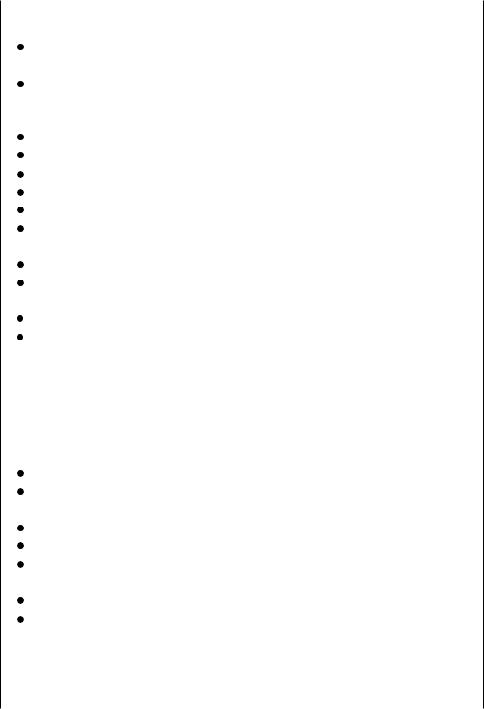
Safety information |
en |
|
|
At time of delivery
Check packaging and dishwasher immediately for signs of transport damage. If the appliance is damaged, do not put it into use but contact your supplier or customer service without delay. Please dispose of packaging materials properly.
During installation
Place the dishwasher and connect it up in accordance with the installation instructions.
The dishwasher must not be connected to the electricity supply while installation is being carried out. Ensure that the domestic wiring is properly earthed.
The mains electricity supply must conform to the details shown on the dishwasher nameplate. Do not connect the dishwasher to the electricity supply via an extension cable.
Built-under and built-in appliances should always be installed under a continuous work surface which is attached to the adjacent cupboards, in order to ensure that the appliance is entirely stable.
After the appliance has been installed,the mains plug should still be easily accessible.
The plastic housing on the water inlet contains an electrically operated valve.The connecting wires are inside the inlet hose.Do not cut through this hose and do not immerse the plastic housing in water. During installation, the power supply cord must not be excessively or dangerously bent or flattened. For Switzerland only:
There are no restrictions on installing the appliance between wooden or plastic walls as part of a fitted kitchen. If the appliance is not plugged into a wall socket, it must be connected to the mains via a separator for all poles within the domestic wiring system. This device must have a gap of at least 3mm between open contacts, in order to conform with relevant safety regulations.
During normal use
The dishwasher must only be used by adults for the washing of household dishes and cooking utensils. This appliance cannot be installed outdoor, not even if the area in which it is installed is covered by a roof; it is also very dangerous to leave it exposed to the rain and elements.
Do not place any heavy objects or stand on the door when it is open. The appliance could tip forward. The water inside the dishwasher is not suitable for drinking.
Do not use solvents of any kind inside your dishwasher. They could cause an explosion danger. Open the door very carefully if the dishwasher is operating. There is a risk of water squirting out. Do not touch the heating element during or after a wash cycle.
Fundamental rules to follow when using the appliance:
-Never touch the dishwasher when barefoot or with wet hands or feet;
-We discourage the use of extension cords and multiple sockets;
-If the appliance is not operating properly or maintenance must be performed, disconnect the appliance from the power supply.
2
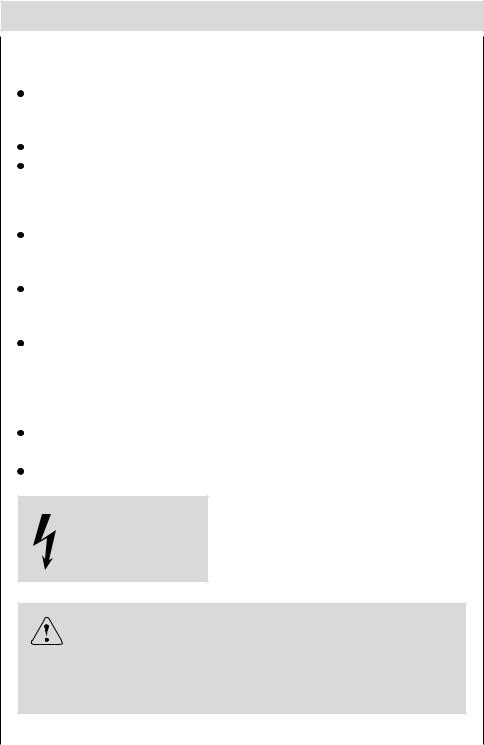
en
If your family includes children
This appliance is not intended for use by persons (including children) with reduced physical,sensory or mental capcabilities, or lack of experience and knowledge,unless they have been given supervision or instruction concerning use of the appliance by a person responsible for their safety.
Children should be supervised to ensure that they to not play with the appliance.
Keep detergents out of the reach of children, who must also be kept away from the dishwasher when it is open.
If a fault occurs
If the appliance malfunctions, turn off water supply to the appliance and disconnect the plug from the wall socket. Then, consult the section entitled, "Fault finding" .If you cannot solve the problem, contact a service center.
Only specialised personnel are authorised to make repairs.
 If the supply cord is damaged ,it must be replaced by the manufacture ,its service agent of similarly qualified persons in order to avoid a hazard.
If the supply cord is damaged ,it must be replaced by the manufacture ,its service agent of similarly qualified persons in order to avoid a hazard.
To maintain the EFFICIENCY and SAFETY of this appliance,we recommend:
-call only the Service Centers authorized by the manufacturer.
-always use original Spare Parts.
When disposing of old appliances
Appliances which are no longer being used must be made inoperable by cutting the power supply cord and removing the door lock.
Take the appliance to a designated waste disposal center.
Dangerous voltage
Warning
Children could get locked in the appliance (risk of suffocation) or get stuck in other positions. Therefore: Remove the mains plug, cut the mains wire and set aside. Damage the door lock so that the door can no longer be closed.
3
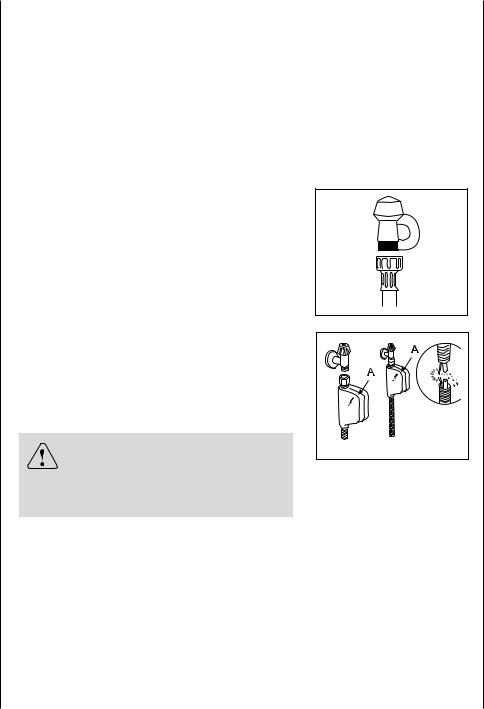
Installation |
en |
|
|
Positioning the appliance
Change the appliance in the desired location. The back should rest against the wall behind it, and the sides, along the adjacent cabinets or wall. The dishwasher is equipped with water supply and drain hoses that can be positioned to the right or the left to facilitate proper installation.
Levelling the appliance
Once the appliance is positioned, adjust the feet (screwing them in or out) to adjust the dishwasher, making it level. In any case, the appliance should not be inclined more than 2˚. If the appliance is levelled, it will help ensure proper performance.
Cold water connection
Connect the water supply hose to a threaded 3/4 (gas) connector, making sure that it is fastened tightly in place (see fig.A).
Some models are fitted with an "Aquastop" water supply hose (see fig.B) in which the small filter is already housed in the threaded end.
If the water pipes are new or have not been used for an extended period of time, let the water run to make sure that the water is clear and free of impurities. If this precaution is not taken, there is a risk that the water inlet can get blocked and damage the appliance.
Warning
The appliance is to be connected to the water mains using new hose-sets and that old hose-sets should not be reused.
fig.A
fig.B
Anti-Flooding protection
If dishwasher is equipped with a system that stops the supply of water in the event of a problem with the water supply hose, or leaks within the unit, in order to prevent damage to your home. If for any reason the box containing the electrical components happens to get damaged, remove the plug for the appliance from the socket immediately. In order to guarantee that the anti-flooding feature operates properly, the "A" box with water supply hose must be attached to the water supply tap as shown in fig.B. No other type of connection is acceptable. The water supply hose must not, under any circumstances, be cut, as it contains electrical parts which are live. If the length of the hose is not adequate to make a proper connection, the hose must be replaced with one which is long enough. This hose is available upon request from specialised retailers and service center.
4
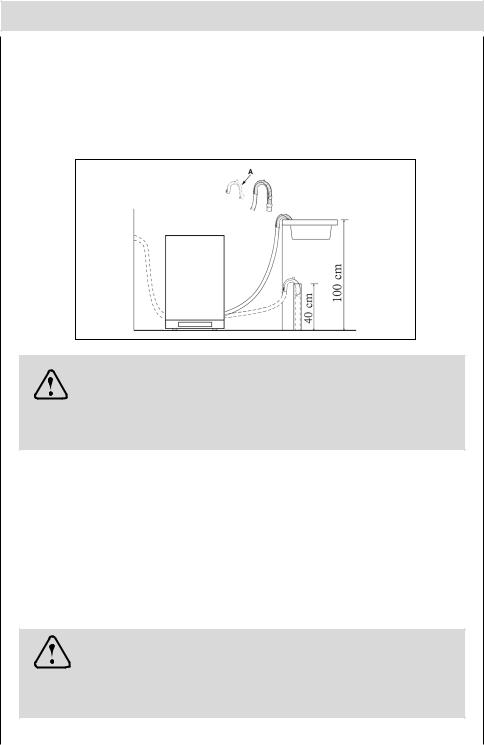
en
Drain hose connection
Insert the drain hose into a drain pipe with a minimum diameter of 4cm, or let it run into the sink, making sure to avoid bending or crimping it. If necessary, fit a syphon trap (U-bend) with a connecting piece for the drain hose (fig.C). The free end of the hose must be at a height between 40 and 100 cm and must not be immersed in water.
fig.C
Attention:
The connecting piece for syphon trap (U-bend) must be solidly fastened to the wall to prevent the drain hose from moving and allowing water to spill outside the drain.
Electrical Connection
After making sure that the voltage and frequency values for the current in the home correspond to those on the rating plate (located on the stainless steel inner door of the appliance) and that the electrical system is correct for the maximum voltage on the rating plate, insert the plug into an electrical socket which is earthed properly (the earthing of the appliance is a safety requirement mandated by law).
If the electrical socket to which the appliance must be connected is not appropriate for the plug, replace the whole cable, rather than using adaptors or the similar like as they could cause overheating and burns.
Caution:
The dishwasher plug must be accessible even when the appliance is installed as a built-in unit so that maintenance can be done safely.
5
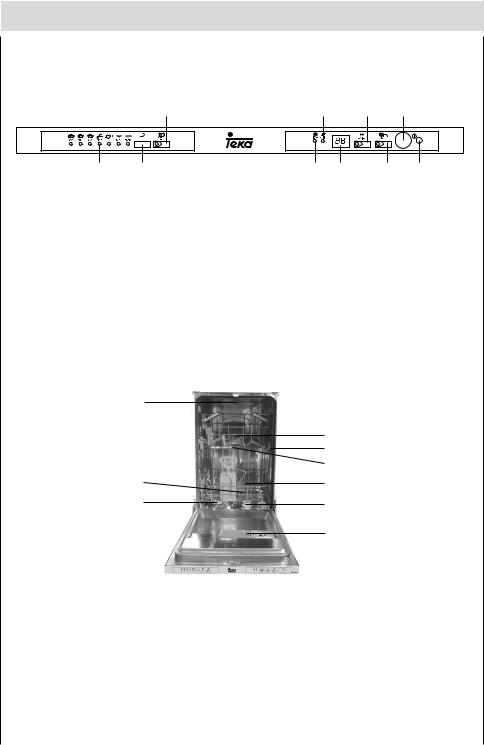
Getting to know your dishwasher |
|
|
en |
||
Close-up view (control panel) |
|
|
|
|
|
|
C |
|
E |
G |
I |
A |
B |
|
D F |
H |
J |
A Programme Indicator |
F |
Time-remaining Indicator |
|||
B Programme Button |
G |
Delayed Start Button |
|
||
C "3 in 1" Button |
H |
" 1/2 " Button |
|
||
D Low Rinse Aid Indicator |
I |
ON-OFF Button |
|
||
E Low Salt Indicator |
J |
ON-OFF Indicator |
|
||
Dishwasher interior |
|
|
|
|
|
|
i |
|
|
|
|
|
|
|
a |
|
|
|
|
|
b |
|
|
|
|
|
c |
|
|
|
h |
|
d |
|
|
|
g |
|
e |
|
|
f
a |
Upper Rack |
f |
Detergent and Rinse Aid Dispenser |
b |
Rack Height Adjustor |
g |
Salt Container Cap |
c |
Top Spray Arm |
h |
Bottom Spray Arm |
d |
Lower Rack |
i |
Third Sprayer |
e |
Washing Filter |
|
|
6
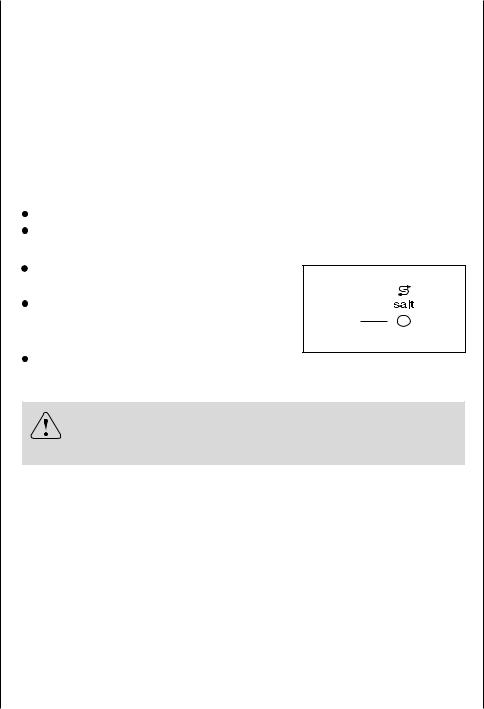
How to fill the salt |
en |
|
|
Salt
The hardness of the water varies from place to place. If hard water is used in the dishwasher, deposits will form on the dishes and utensils.
The appliance is equipped with a special softener that uses a salt specifically designed to eliminate lime and minerals from the water.
Loading the salt into the container
Always use salt intended for use with dishwashers.
The salt container is located beneath the lower rack and should be filled as follows:
When the low salt indicator “E” lights, you must fill the salt. Remove the lower rack and then unscrew and remove the cap from the salt container;
If you are filling the container for the first time, fill it with water;
Place the end of the funnel (supplied) into the hole and
introduce about 2 kg of salt. It is normal for a small amount E of water to come out of the salt container.
Carefully screw the cap back on.
Important
To prevent the formation of rust, load the salt just before beginning a
wash cycle.
7
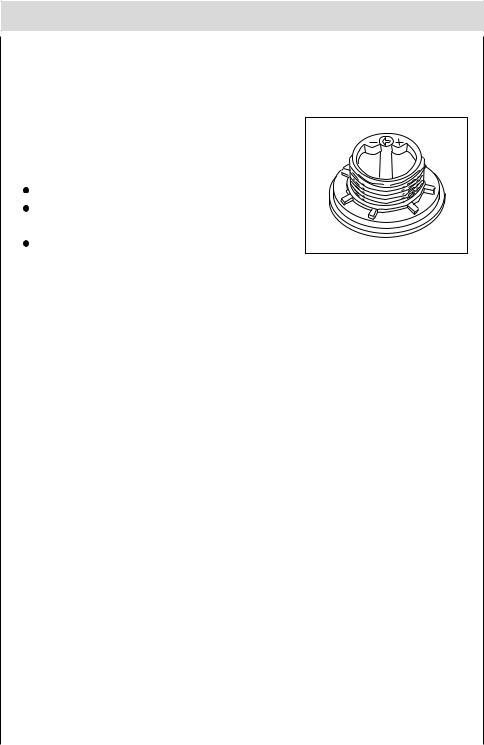
en
Adjusting salt consumption
The dishwasher is designed to allow for adjusting the amount of salt consumed based on the hardness of the water used. This is intended to optimize and customize the level of salt consumption so that it remains at a minimum.
To adjust salt consumption, proceed as follows:
Unscrew the cap from the salt container;
There is a ring on the container with an arrow on it (see figure to the side),
If necessary, rotate the ring in an anticlockwise direction from the "-" setting towards the "+" sign, based on the hardness of the water being used.
It is recommended that adjustments be made in accordance with the following table:
|
Water Hardness |
|
|
|
|
||
|
|
|
|
|
|
|
|
|
|
|
|
|
Selector |
Salt |
Autonomy |
Level |
|
Clarke |
ºdH |
|
c o n s u m p t i o n |
||
|
mmol/l |
(cycles/2kg) |
|||||
|
|
degrees |
|
|
position |
(Grams/cycle) |
|
|
|
|
|
|
|
|
|
1 |
|
0 - 14 |
0 - 17 |
0 - 1,7 |
/ |
0 |
/ |
|
|
|
|
|
|
|
|
2 |
|
14 - 36 |
18 - 44 |
1,8 - 4,4 |
"-" |
20 |
60 |
|
|
|
|
|
|
|
|
3 |
|
36 - 71 |
45 - 89 |
4,5 - 8,9 |
middle |
40 |
40 |
|
|
|
|
|
|
|
|
4 |
|
>71 |
>89 |
>8,9 |
"+" |
60 |
25 |
|
|
|
|
|
|
|
|
8

How to fill rinse aid |
en |
Rinse aid
This product makes dishes sparkle and helps them to dry without spotting. The dispenser is located on the inside panel of the door .
When the low rinse aid indicator “ D ” lights , you must load rinse aid .
D
Loading the rinse aid
Regardless of the type of detergent dispenser installed on |
|
your appliance, you must proceed as indicated below when |
|
loading the rinse aid. |
|
To open the dispenser, turn the "1" cap in an anti-clockwise |
|
direction and then pour in the rinse aid, making sure not to |
1 2 |
overfill. The amount of rinse aid used for each cycle can be |
|
regulated by turning the "2" dose adjuster, located beneath |
|
the "1" cap, with a screwdriver. |
|
There are 6 different settings; the normal dosage setting is |
|
3. |
|
Important
Proper dosage of the rinse aid improves drying.
If drops of water remain on the dishes or spotting occurs, the dosage adjuster should be turned to a higher setting.
If the dishes have white streaks, turn the dosage adjuster to a lower setting.
9
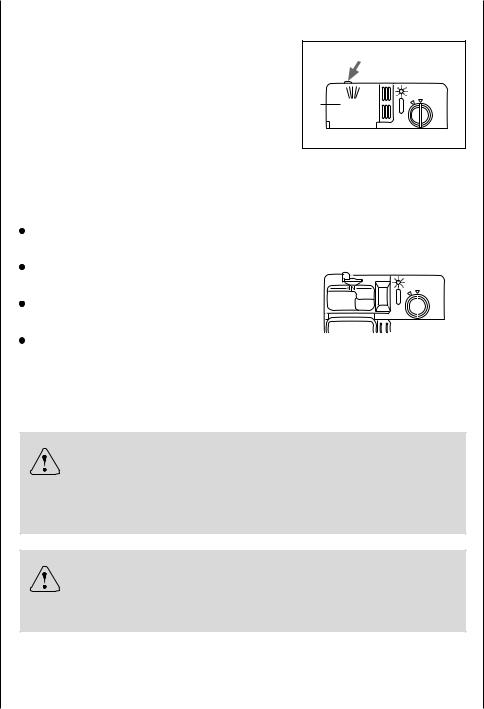
How to fill the detergent |
en |
|
|
Detergent
Detergent specifically intended for use with dishwashers must be used. The dispenser must be refilled before the start of each wash cycle following the instructions provided in the "Programme overview". The detergent dispenser is located on the inside panel of the door.
4 |
3 |
Loading the detergent
To open the " 3 " cover on the dispenser, press the " 4 " |
|
|
|
|
button. |
6 |
|
||
The detergent for the wash cycle should be poured into |
|
|
|
|
|
|
|
|
|
the " 5 " compartment. |
|
|
|
|
The detergent for the pre-wash cycle should be poured |
|
|
|
|
|
|
|
|
|
into the “ 6 ” compartment. |
|
|
|
|
|
|
|
|
|
After the detergent has been placed in the dispenser, |
|
|
|
|
5 |
|
|
||
|
|
|
||
close the cover and press down until it clicks in place. |
|
|
|
|
Notice:
To facilitate closing the cover, remove any excess of detergent on the edges of the dispenser.
Notice:
The usage of 3 in 1 or similar tablets is forbidden when Heat wash, Rapid Wash and Soak programmes are selected.
10
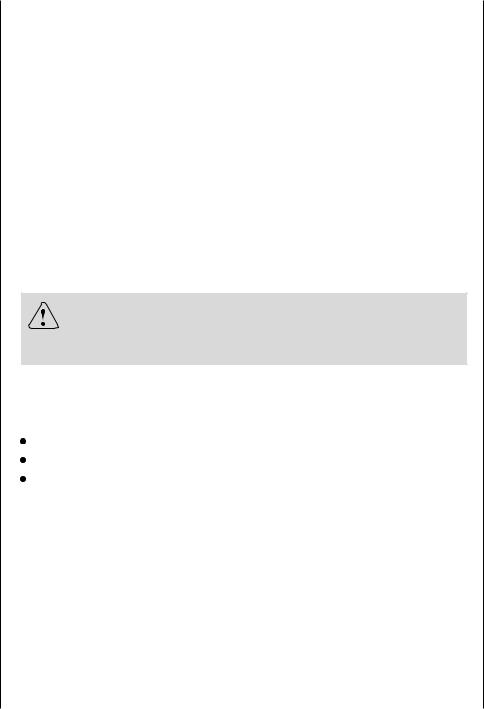
Not suitable for the dishwasher |
en |
|
|
What you should not put into the dishwasher
Cutlery and tableware manufactured in whole or part from wood.They become faded and unsightly in appearance.Furthermore,the adhesives that are used are not suitable for the temperature that occur inside the dishwasher.Delicate decorative glassware and vases,special antique or irreplaceable china. The decorative patterns on such items will not be dishwasher-proof.
Plastic objects that are not resistant to hot water, copper and pewter utensils are also not suitable. Decorative patterns printed or painted onto the surface of crockery, glasses, etc.,aluminium and silver items tend to become discoloured or faded if washed in the diswasher. Some types of glass can become opaque in appearance after they have been washed many times in a dishwasher. Highly absorbent materials, such as sponges and towels,should never be placed in the dishwasher.
Our recommendation
In future, only purchase table or kitchenware that has been confirmed as being dishwasher-proof.
Important
Dishes or cutlery that have been soiled by tobacco ash, wax,
Iubricating grease or paint, should not be put in the dishwasher.
Damage to glassware and other dishes
Possible causes
type of glass or manufacturing process chemical composition of detergent
water temperature and duration of dishwasher programme.
Suggested remedy
 Use glassware or porcelain dishes that have been marked ‘dishwasher-proof’ by the manufacturer.
Use glassware or porcelain dishes that have been marked ‘dishwasher-proof’ by the manufacturer.
 Use a mild detergent that is described as ‘kind to dishes’. If necessary, seek further information from detergent manufacturers.
Use a mild detergent that is described as ‘kind to dishes’. If necessary, seek further information from detergent manufacturers.
 Select a programme with a low temperature and a short duration as possible.
Select a programme with a low temperature and a short duration as possible.
 To prevent damage, take glass and cutlery out of the dishwasher as soon as possible after the programme has ended.
To prevent damage, take glass and cutlery out of the dishwasher as soon as possible after the programme has ended.
11
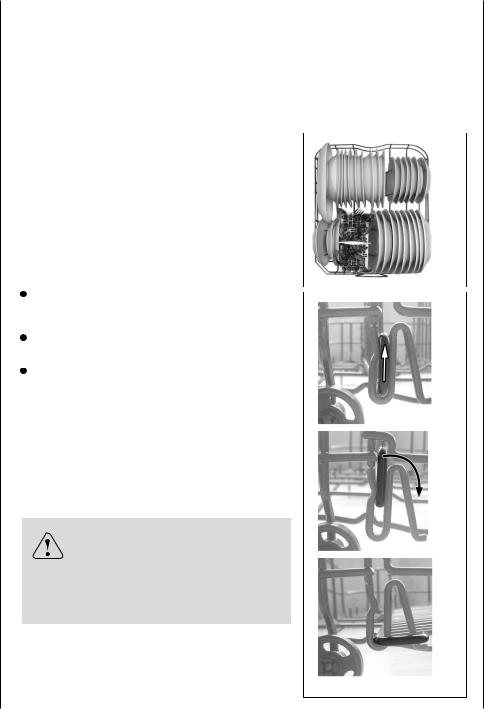
Arranging crockery, glasses, etc. in the dishwasher |
en |
|
|
Before placing the dishes in the dishwasher, remove larger food particles to prevent the filter from becoming clogged, which results in reduced performance.
If the pots and pans have baked-on food that is extremely hard to remove, we recommend that they are soaked before washed. This will eliminate the need for extra wash cycles.
Pull out the rack to load the dishwasher.
How to use the lower rack |
Normal daily load |
|
|
|
We recommend that you place the most difficult to clean items on the bottom rack: pots, pans, lids, serving dishes and bowls, as shown in the figure to the right.
It is preferable to place serving dishes and lids on the sides of |
|
the racks in order to avoid blocking the rotation of the top spray |
|
arm. |
fig.D |
|
|
Pots, serving bowls, etc. must always be placed face down |
|
|
|
|
|
(see fig.D) . |
|
Deep pots should be slanted to allow the water to flow out. |
|
The lower rack features fold down tine rows (see fig.E) so |
|
that larger or more pots and pans can be loaded. |
|
|
E1 |
Warning
E2
knives and other utensils with sharp points must be loaded in the basket with their points down or placed in a horizontal position.
E3
fig.E
12
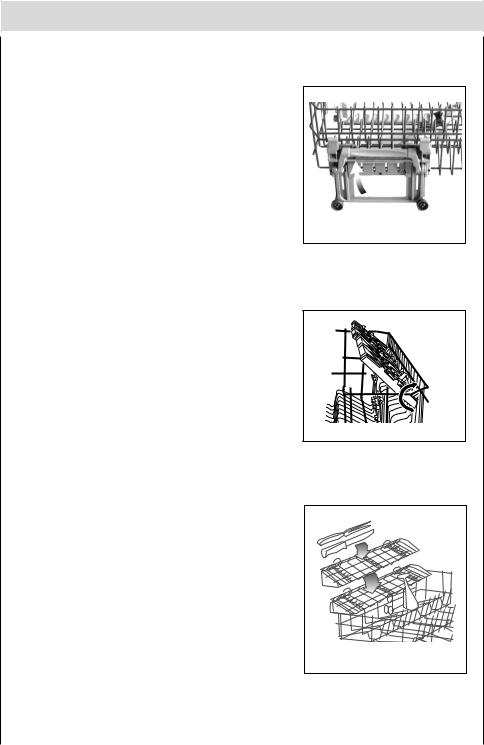
How to use the upper rack
The upper rack is designed to hold more delicate and lighter dishware, such as glasses, cups and saucers, plates, small bowls and shallow pans (as long as they are not too dirty).
 Position the dishes and cookware so that they do not get moved by the spray of water.
Position the dishes and cookware so that they do not get moved by the spray of water.
 The upper rack can be adjusted for height by using the knobs located on the sides of the rack itself (see fig.F).
The upper rack can be adjusted for height by using the knobs located on the sides of the rack itself (see fig.F).
Adjust the upper basket to the higher level and you have more space to accommodate those taller pans and trays in the bottom basket.
en
fig.F
Shelf
Lean tall glasses and those with long stems against the shelfnot against other items to be washed.
Place glasses, cups and small bowls on the additional cup rack. The additional cup rack can be swivelled in or out as required
(see fig.G).
fig.G
Knife rack
The knife rack clips onto the side of the top basket, giving you the freedom to wash your large sharp knives separately and out of harm’s way (see fig.H).
fig.H |
13

Programme overview |
en |
|
|
|
|
|
|
|
|
|
|
Type of |
Type of |
Amount of |
Condi- |
|
|
|
|
|
|
|
||
|
|
Wash |
crokery e.g. |
|
|
|
|
|
|
|
||||||||||
|
|
|
china, pots/ |
food |
food |
tion of |
Description of cycle |
1/2 |
3 in 1 |
|||||||||||
programme |
|
food |
||||||||||||||||||
|
pan s, |
remains |
remains |
|
Load |
|
|
|
||||||||||||
|
|
|
|
|
|
|
|
cutiery, |
remains |
|
|
|
|
|||||||
|
|
|
|
|
|
|
glasses, etc |
|
|
|
|
|
|
|
|
|
||||
|
|
|
|
|
|
|
|
|
|
|
|
|
|
|
|
|
|
|||
|
|
|
|
|
|
|
|
|
|
|
|
|
|
Pre-wash with hot water. |
|
|
|
|
|
|
|
|
|
|
|
|
|
|
|
|
Soups, |
|
|
|
Extended wash at 70°C. |
|
|
|
|
|
|
|
|
|
|
|
|
|
|
|
|
|
|
|
|
|
|
|
|
|
||
|
|
|
|
|
|
|
|
|
|
|
|
|
Rinses with cold water. |
|
|
|
|
|
|
|
Intensive |
|
|
|
casseroles, |
|
|
|
|
|
|
|
|
|
|||||||
|
|
|
|
|
|
|
|
|
|
|
|
|||||||||
|
|
|
|
stuck |
Rinse with hot water. |
|
|
|
|
|
|
|||||||||
|
|
|
sauces, |
|
|
|
|
|
|
|
||||||||||
|
|
|
|
|
|
|
|
Non- |
a lot |
|
|
|
|
|
|
|||||
|
|
Wash |
|
on hard |
Drying. |
|
|
|
|
|
|
|||||||||
|
|
|
potatoes, |
|
|
|
|
|
|
|||||||||||
|
|
|
delicate |
|
|
|
|
|
|
|
||||||||||
|
|
|
|
|
|
|
|
pasts, rice, |
|
|
|
Pre-wash use cold water. |
|
|
|
|
|
|
||
|
|
|
|
|
|
|
|
|
|
|
|
|
|
|
|
|
|
|
||
|
|
|
|
|
|
|
|
|
|
|
|
|
Extended wash at 55°C. |
|
|
|
|
|
|
|
|
|
|
|
|
|
|
|
|
|
eggs, roast or |
|
|
|
|
|
|
|
|
|
|
|
|
|
|
|
|
|
|
|
|
|
|
|
|
|
|
|
|
|
||
|
|
|
|
|
|
|
|
|
|
|
|
|
Rinse with cold water. |
|
|
|
|
|
|
|
|
Normal |
|
|
|
fried food. |
|
|
|
|
|
|
|
|
|
||||||
|
|
|
|
|
|
|
|
|
|
|
|
|
||||||||
|
|
|
|
|
|
|
Rinse with hot water. |
|
|
|
|
|
|
|||||||
|
|
|
|
|
|
|
|
|
|
|
|
|
|
|||||||
|
|
|
|
|
|
|
|
|
|
|
|
|
|
|
|
|
|
|
|
|
|
|
Wash |
|
|
|
|
|
|
|
Drying. |
|
|
|
|
|
|
||||
|
|
|
|
|
|
|
|
|
|
Soups, |
|
|
|
Pre-wash use cold water. |
|
|
|
|
|
|
|
|
|
|
|
|
|
|
|
|
potatoes, |
a little |
loosely |
Extended wash at 50°C. |
|
|
|
|
|
|
|
|
|
|
|
|
|
|
|
|
|
|
|
|
|
|
|
|||||
|
|
|
|
|
|
|
|
|
|
pasta, rice, |
attached |
Rinse with cold water. |
|
|
|
|
|
|
||
Light Wash |
|
|
|
|
|
|
|
|
|
|
||||||||||
|
|
|
eggs, roast or |
|
|
|
Rinse with hot water. |
|
|
|
|
|
|
|||||||
(EN50242) |
|
|
|
fried food. |
|
|
|
Drying. |
|
|
|
|
|
|
||||||
|
|
|
|
|
|
|
|
|
|
|
|
|
|
|
|
|
|
|
|
|
|
|
|
|
|
|
|
|
|
|
|
|
|
|
Wash at 45°C. |
|
|
|
|
|
|
|
|
|
|
|
|
|
|
|
|
|
|
|
|
Rinse with cold water. |
|
|
|
|
|
|
Glass ware |
|
|
|
Coffee,cakes, |
|
|
|
Hot rinse. |
|
|
|
|
|
|
||||||
|
|
|
|
|
|
|
|
|
|
|
|
|||||||||
|
|
|
|
|
|
Drying. |
|
|
|
|
|
|
||||||||
|
|
|
|
|
|
|
|
|
|
milk, sausage, |
Very little |
loosely |
|
|
|
|
|
|
|
|
|
|
|
|
|
|
|
|
|
|
cold drinks, |
attached |
|
|
|
|
|
|
|
||
|
|
|
|
|
|
|
|
|
|
|
|
|
|
|
|
|
|
|||
|
|
|
|
|
|
|
|
|
|
|
|
|
|
|
|
|
|
|||
|
|
|
|
|
|
|
|
Mixed |
salads |
|
|
|
Short wash at 40°C. |
|
|
|
|
|
|
|
|
|
|
|
|
|
|
|
|
|
|
|
|
|
|
|
|
||||
|
|
|
|
|
|
|
|
|
|
|
|
|
|
|
|
|
||||
|
|
|
|
|
|
|
|
|
|
|
|
|
|
|
|
|
|
|||
Rapid wash |
|
|
|
|
|
Cold rinse. |
|
|
|
|
|
|
||||||||
|
|
|
|
|
|
|
|
|
|
|
|
|
||||||||
|
|
|
|
|
|
|
|
|
|
|
|
|
|
|||||||
|
|
|
|
|
|
|
|
|
|
|
|
|
|
|||||||
|
|
|
|
|
|
|
|
|
|
|
|
|
|
|
|
|
|
|
|
|
|
|
|
|
|
|
|
|
|
|
For dishes that need to be rinsed |
Hot rinse at 65°C. |
|
|
|
|
|
|
|||
|
|
|
|
|
|
|
|
|
|
|
|
|
|
|
|
|||||
Heat wash |
|
|
|
and dried only. |
|
|
|
Drying. |
|
|
|
|
|
|
||||||
|
|
|
|
|
|
|
|
|
|
|
|
|
|
|||||||
|
|
|
|
|
|
|
|
|
|
|
|
|
|
|||||||
|
|
|
|
|
|
|
|
|
|
|
|
|
|
|
|
|
|
|
|
|
|
|
|
|
|
|
|
|
|
|
Rinse off if the dishes have been |
Short cold wash to pre- |
|
|
|
|
|
|
|||
|
|
|
|
|
|
|
|
|
|
|
|
|
|
|
|
|||||
|
|
|
|
|
|
|
|
|
|
|
|
|
|
|
|
|||||
|
|
|
|
|
|
|
|
|
|
stacked for several days in the dish- |
vent food residue from |
|
|
|
|
|
|
|||
|
|
|
|
|
|
|
|
|
|
|
|
|
|
|
|
|||||
|
|
|
|
Soak |
|
|
|
washer prior to washing. |
|
|
drying on the dishes . |
|
|
|
|
|
|
|||
|
|
|
|
|
|
|
|
|
|
|
|
|
|
|
|
|
|
|||
|
|
|
|
|
|
|
|
|
|
|
|
|
|
|
|
|
|
|
|
|
14
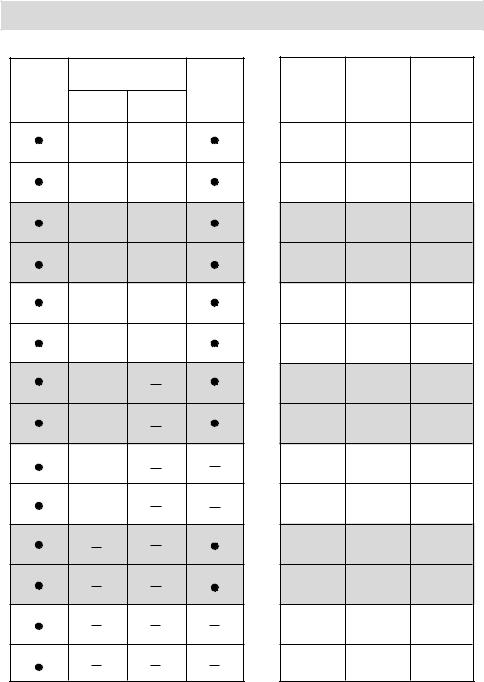
en
Delayed |
Detergent |
|
|
Energy |
Water |
|
|
|
Rinse Aid |
Duration in |
|||
Start |
|
|
consump- |
consump- |
||
Extended |
|
|
||||
Prewash |
|
minutes |
||||
|
|
tion in kWh |
tion in litres |
|||
|
Wash |
|
|
|
||
|
|
|
|
|
|
|
|
25g |
5g |
EN50242 |
112 |
1.44 |
18 |
|
25g |
5g |
94 |
1.25 |
16 |
|
|
Standard |
|||||
|
25g |
5g |
102 |
1.11 |
15 |
|
|
|
|||||
|
25g |
5g |
withEuropean |
90 |
1.00 |
14 |
|
25g |
5g |
140 |
0.76 |
13 |
|
|
25g |
5g |
|
162 |
0.81 |
15 |
|
15g |
|
accordance |
92 |
1.01 |
12 |
|
|
|
||||
|
10g |
|
in |
82 |
0.95 |
10 |
|
|
|
|
|
||
|
15g |
|
valve |
32 |
0.40 |
9 |
|
10g |
|
measured |
28 |
0.30 |
8 |
|
|
|
Laboratory |
54 |
0.90 |
5.5 |
|
|
|
|
|||
|
|
|
|
48 |
0.78 |
5 |
|
|
|
|
12 |
0.02 |
3 |
|
|
|
|
12 |
0.02 |
3 |
15

Washing dishes |
en |
|
|
Programme selection
The most appropriate programme can be identified by comparing the type of crockery, cutlery, etc., as well as the amount and condition of food remains, with the details contained in the wash cycle table.The corresponding programme sequence, duration and consumption details are shown in the right half of the overview.
For example:
Use the« normal» 
 programme for dishes and utensils which have plenty of food remains stuck on hard.
programme for dishes and utensils which have plenty of food remains stuck on hard.
Earn savings
If only a small number of dishes have been loaded into the dishwasher,selecting a programme that operates at the next lowest temperature will usually be sufficient.
Programme data
The stated programme data are based on standard operating conditions. The values can vary considerably according to:
 different amounts of dishes
different amounts of dishes
 temperature of mains water supply
temperature of mains water supply
 pressure of mains water supply
pressure of mains water supply
 ambient temperature
ambient temperature
 fluctuations in mains voltage
fluctuations in mains voltage
 machine-related factors (e.g. temperature, water volume,...)
machine-related factors (e.g. temperature, water volume,...)
16
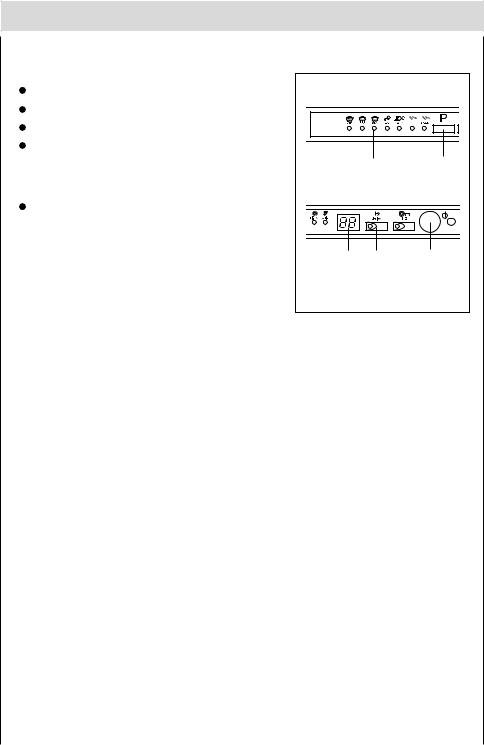
|
|
en |
Switching the dishwasher ON |
|
|
Turn on the tap. |
|
|
Open the door. |
|
|
Set ON-OFF button “I” to ON. |
|
|
Press programme button “B” , programme indicator |
|
|
“ A” lights and the time-remaining indicator “ F ” dis- |
A |
B |
plays the time of the programme.. |
|
|
If the door is closed, the programme indicator “A” be- |
|
|
comes to light and the dishwasher beeps one time , |
|
|
then the programme starts automatically. |
|
|
F |
G |
I |
End of programme
 Six beeps will indicate that the wash cycle has finished.
Six beeps will indicate that the wash cycle has finished.
Switching the dishwasher OFF
Several minutes after the programme has ended:
 Open the door.
Open the door.
 Set ON-OFF button “ I ” to OFF.
Set ON-OFF button “ I ” to OFF.
 Remove dishes, etc. when they have cooled down.
Remove dishes, etc. when they have cooled down.
Interrupping the programme
 A cycle that is underway can be modified if it has only been running for a short time. Otherwise, the detergent may have already been used, and the appliance may have already drained the wash water. If this is the case, the detergent dispenser must be refilled ( see the paragraph entitled, “ Loading the detergent ”).
A cycle that is underway can be modified if it has only been running for a short time. Otherwise, the detergent may have already been used, and the appliance may have already drained the wash water. If this is the case, the detergent dispenser must be refilled ( see the paragraph entitled, “ Loading the detergent ”).
 Open the door. Caution! There is a risk of water squirting out from inside the appliance. Do not open the door fully until spray arm has stopped rotating.
Open the door. Caution! There is a risk of water squirting out from inside the appliance. Do not open the door fully until spray arm has stopped rotating.
 When you open the door, the dishwasher will beep ten times every thirty seconds.
When you open the door, the dishwasher will beep ten times every thirty seconds.
 If the appliance has already heated up or the hot water was switched ON and then the appliance door opened, leave the door ajar for several minutes and then close. Otherwise, the appliance door may open due to expansion.
If the appliance has already heated up or the hot water was switched ON and then the appliance door opened, leave the door ajar for several minutes and then close. Otherwise, the appliance door may open due to expansion.
17

en
Delayed start programming
You can delay the start of a programme in increments of 1 hour up to 24 hours.
Switch dishwasher ON.
Press programme button “ B ” to choose the desired programme.
Immediately press the Delayed Start button “ G ”, the delayed start indicator lights, the delayed start time indicator “ F ” changes to “  ”.
”.
Press the Delayed Start button “ G ” as many times as necessary until the numerical display shows the required delay.
To cancel the time delay setting, pressing the Delayed Start button until the delayed start indicator goes out.
Close the door, the delayed start indicator “ G ” blinks , the time-remaining indicator “ F ” will blink and decrease, the programme will start until the delayed start indicator “ G ” goes out .
A B F G H I
1/2 Load Button
This button “H” (see" Close-up View (Control Panel) ) makes it possible to wash dishes using only the upper rack if there are not enough dishes for a full load. This will allow you to save on water and energy consumption.
To select 1/2 load:
 Select the programme ( see the paragraph entitled“ Switching the dishwaher ON”)
Select the programme ( see the paragraph entitled“ Switching the dishwaher ON”)
 Press the 1/2 load button “ H ” , 1/2 load indicator lights.
Press the 1/2 load button “ H ” , 1/2 load indicator lights.
 If the door is closed, the programme starts automatically.
If the door is closed, the programme starts automatically.
To cancel the 1/2 load while underway
 Press programme button “ B ” and hold it in for about 3 seconds.
Press programme button “ B ” and hold it in for about 3 seconds.
- Please keep in mind that the amount of detergent should also be adapted to the 1/2 load.
18
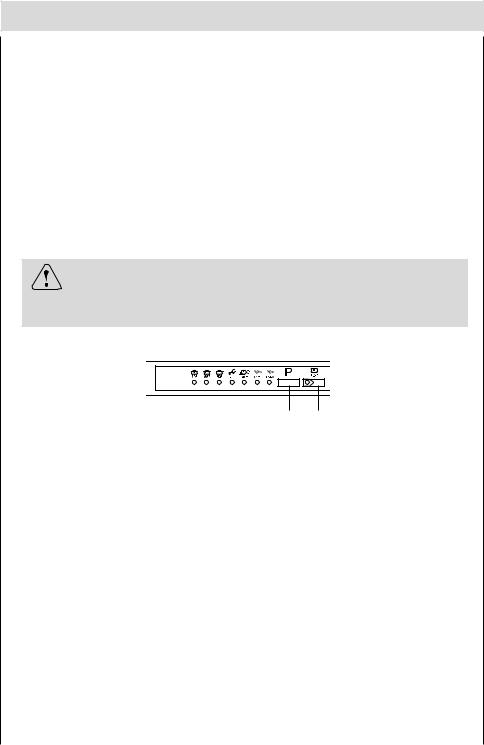
en
3in1 function
When using "3 in 1"combination products, the rinse-aid and salt lights are no longer useful. It may be helpful therefore to switch the rinse aid off (please note that only some dishwashers have this facility) and selecting the lowest possible setting for water hardness.
If you decide to switch to the use of a standard detergent system we advise that you:
1:Refill both the salt and rinse aid compartments.
2:Switch the waterhardness setting to the highest possible position and run for three normal cycles without a load.
3:Readjust the waterhardness setting again according to the conditions for your region (For more information please refer to your instruction manual).
Notice:
Do not place the tablets in the tub or the cutlery basket as this will result in poorer wash results. The tablets should be placed in the detergent doser.
B C
Memory Function Module
If the dishwasher is switched off through the ON/OFF button, or a current leak happens while the selected washing program is active, the program is not cancelled. The controls use a microprocessor device, to memorize the information about the selected washing program. Once the machine is again powered on, the dishwasher will be resumed from the point it was interrupted.
Canceling or modifying a washing program cycle
1:To modify or cancel the carrying out of a washing cycle (being the door opened), it's necessary to reset the previous programming, by holding pushed the programme selector button “B” for at least 3 seconds, and the buzzer emits one short warning signal.
2:If the reset operation was successful, a drain phase is started. Once the drain phase is ended, the dishwasher stands waiting for a new programming
3:A cycle that is underway can be modified if it has only been running for a short time. Otherwise, the detergent may have already been used, and the appliance may have already drained the wash water. If this is the case, the detergent dispenser must be refilled.
19

en
Tabs
With Classic Tabs you can put your dirtiest dishes straight into the dishwasher. The tab contains StainSoakers which dissolve instantly to soften really dried on food residues such as baked on egg and cheese sauces. The blue layer then works to break down and lift off food remains while the white layer cleans all traces of dirt away for a spotless and brilliant finish.
For best results use with Rinse Aid and Special Salt.
Directions: Simply unwrap one tab and place in the detergent dispenser of your dishwasher. For best results, use with Rinse Aid and Special Salt.
3in1 Tabs
With powerful grease cutting action, 3in1 Tabs effectively remove tough stains, so you don't have to rewash!
The blue layer contains powerful detergent and Red StainSoaker speckles to soften and break down tough dried-on stains.
The white layer, with its integrated salt function, softens the water and prevents limescale whilst removing all traces of residue.
The 3in1 tab contains a rinse aid ball to deliver a spotless, streak free brilliant shine. 3in1 tabs are pre-measured so there's never any guessing, measuring, mess or waste.
Directions: Simply unwrap one tab and place in the detergent dispenser of your dishwasher. No need to add additional salt or rinse aid. 3in1 Tabs' salt-action is effective in soft, medium and hard water up to 26°„e (around 95% of households).
5in1 Tabs
Are you looking for unbeatable cleaning performance from your dishwashing detergent? 5in1 Tabs have taken dishwashing to the next level with an extra cleaning power to remove encrusted stains for an extreme clean.
1.The tablet is formulated with powerful detergent and red StainSoaker speckles to help penetrate and break down the toughest baked-on and dried-on stains, even tea stains.
2.Using a rinse aid function, the tab is developed for a spotless, streak-free sparkling shine.
3.In the white layer of the tablet, the 5in1 Salt-action prevents limescale deposits in your machine that can result in residue on your glasses.
4.Protector Action helps prevent permanent glass corrosion, a source of cloudy glasses.
5.The tab gives extra cleaning power to help remove encrusted stains for a complete clean.
Directions: Simply unwrap one tab and place in the detergent dispenser of your dishwasher. 5in1 SaltAction is effective in soft, medium and hard water up to 26°„ e (approximately 95% of households).
20

How to keep your dishwasher in shape |
en |
|
|
After Every Wash
After every wash, set the main switch “I” to off and leave the door slightly ajar so that moisture and odors are not trapped inside.
Remove the plug
Before cleaning or performing maintenance, always remove the plug from the socket. Do not run risks.
No solvents or Abrasive Cleaning Products
To clean the exterior and rubber parts of the dishwasher, do not use solvents or abrasive cleaning products. Rather, use only a cloth and warm soapy water.
To remove spots or stains from the surface of the interior, use a cloth dampened with water and a little while vinegar, or cleaning product made specifically for dishwashers.
Moving the Appliance
If the appliance must be moved, try to keep it in a vertical position. If absolutely necessary, it can be positioned on its back.
Seals
One of the factors that cause odors to form in the dishwasher is food that remains trapped in the seals. Periodic cleaning with a damp sponge will prevent this from occurring.
The door should not be left in the open position since this could present a tripping hazard.
When You Go on Holiday
When you go on holiday, it is recommended that you run a wash cycle with the dishwasher empty and then remove the plug from the socket, turn off the water supply and leave the door of the appliance slightly ajar. This will help the seals last longer and prevent odors from forming within the appliance.
21
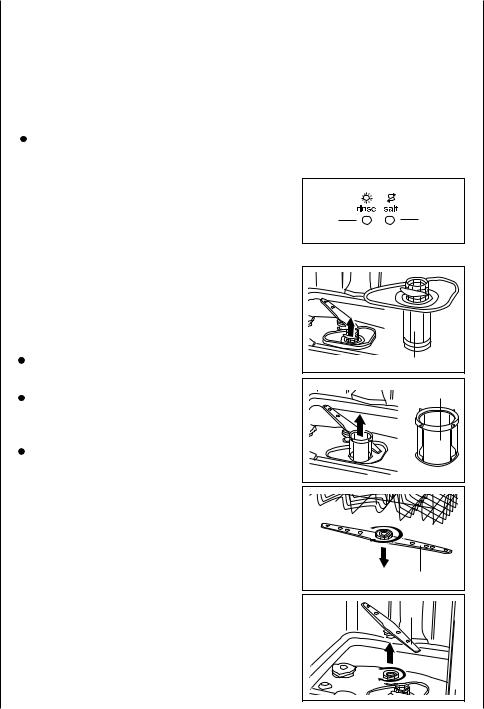
Care and maintenance |
en |
|
|
Regular inspection and maintenance of your appliance helps to prevent problems from occurring.This saves time and aggravation.You should therefore carefully inspect the inside of your dishwasher from time to time.
Overall condition of appliance
 Check that no grease or scale has accumulated on the inside of the dishwasher. If you discover any deposits:
Check that no grease or scale has accumulated on the inside of the dishwasher. If you discover any deposits:
Clean the interior of the dishwasher thorughly with a detergent solution.
Dishwasher salt
Check the LOW SALT indicator “E”. Top up with salt, if required.
Rinse-aid |
D |
E |
|
Check the LOW RINSE AID indicator “ D ”, on the front panel. |
|||
|
|
||
Top up with rinse-aid,if required. |
|
|
|
Filters |
|
|
|
The filters “7”,“8” prevent larger particles of food in the water |
|
|
|
from reaching the pump.These particles may occasionally block |
|
|
|
the filters. |
|
|
|
When the appliance has finished washing, check the filters |
|
7 |
|
for particles of food and, if required, clean. |
|
8 |
|
After undoing the coarse micro-filter “7 ” , the filter unit |
|
||
|
|
||
“ 9” can be removed. Remove any particles of food and |
|
|
|
rinse the filters under running water. |
|
|
|
Insert the filter unit “ 8 ” and tighten the coarse micro-filter. |
|
|
Spray arms
Lime and remnants of food in the washing water can block the nozzles in the spray arms “ 9 ” and “ 10 ” and the arm mountings.  Inspect the nozzles in the spray arms for blocked holes
Inspect the nozzles in the spray arms for blocked holes
due to remnants of food.
 If necessary, pull the lower arm “ 10 ” upwards and lift it off.
If necessary, pull the lower arm “ 10 ” upwards and lift it off.
 Unscrew the upper spray arm “ 9 ”.
Unscrew the upper spray arm “ 9 ”.
 Clean both spray arms under running water.
Clean both spray arms under running water.
 Refit the spray arms. Ensure that the lower arm has locked into place and the upper one is screwed tight.
Refit the spray arms. Ensure that the lower arm has locked into place and the upper one is screwed tight.
9 |
10 |
22
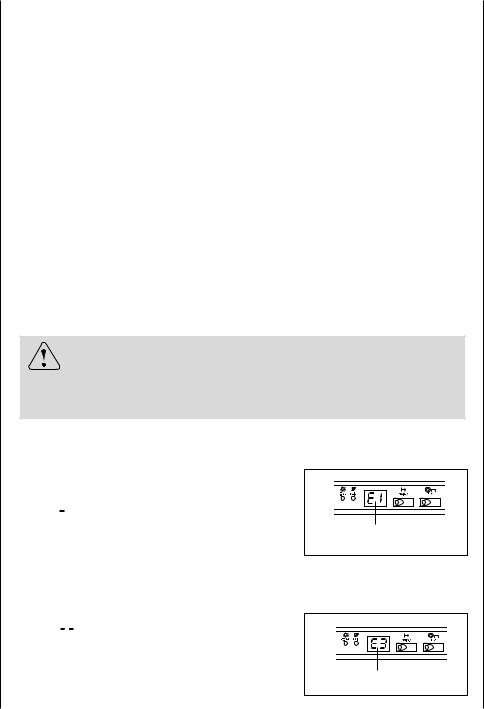
Fault finding |
en |
|
|
Resolving minor problems yourself
Experience has shown that you can resolve most problems that rise during normal daily usage yourself, without having to call out a service engineer.Not only does this save costs,but it also means that the appliance is available for use again that much sooner. The following list of common occurrences and their remedies should help you identify the causes of most problems.
Problems...
...when the appliance is switched on
Appliance does not start up
 Fault with fuse in mains electricity supply.
Fault with fuse in mains electricity supply.
 Plug not inserted in wall socket.
Plug not inserted in wall socket.
 Appliance door not closed properly.
Appliance door not closed properly.
 Programme button has not been pressed.
Programme button has not been pressed.
 Water tap not turned on.
Water tap not turned on.
 Blocked strainer in water intake hose.
Blocked strainer in water intake hose.
- The strainer is situated in the Aquastop or supply-hose connection.
Caution
Do not forget that repairs should only be carried out by a qualified specialist. Improper repairs can lead to considerable equipment damage as well as danger to the user.
...with the appliance itself
Error display on the time-remaining indicator
When “
 ” (F) blinks.
” (F) blinks.
Have you checked whether:
F
 the door is closed properly.
the door is closed properly.
When “ 
 ” (F) blinks.
” (F) blinks.
Have you checked whether:
 the drain hose is too low.
the drain hose is too low.
F
23
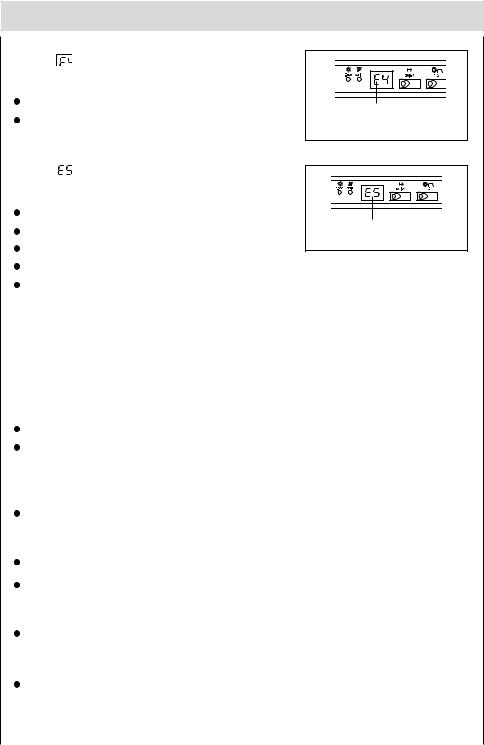
en
When “ |
” (F) blinks. |
|
Have you checked whether: |
|
|
the drain hose is crimped or bent. |
|
|
the drain hose is too high. |
F |
|
When “ |
” (F) blinks. |
|
Have you checked whether: |
|
|
the water is turned on and the hose is connected properly; |
|
|
the water supply to the house is on and has sufficient pressure; |
F |
|
the water supply hose is crimped or bent; |
|
|
the filter for the water supply hose is clogged. |
|
|
the drain hose is too low. |
|
|
If you take all these checks and the dishwasher still does not function or your dishwasher have any other error display, you can power the dishwasher OFF, and wait a few minutes. You can power the dishwasher on, try it again , if the dishwasher still does not function and/or the problem persists, contact the nearest authorised service center and provide them with the following information:
the nature of the problem.
the model type number (Mod...) And the serial number (S/N...), which are indicated on the plate located on the side of the inner part of the door.
Lower spray arm rotates with difficulty
Spray arm is blocked by small items or food remains.
Lid in detergent compartment cannot be closed
Detergent compartment has been overfilled.
Mechanism is clogged with remnants of detergent.
Indicator lamps do not extinguish after washing has finished
Main switch is still set to ON.
Remnants of detergent stuck inside dispenser
Compartment was damp when it was filled up with detergent. Compartment must be dry before detergent is added.
24

en
Water remains inside appliance after programme has ended
 Blockage or kind in drainage hose.
Blockage or kind in drainage hose.
 Pump is jammed.
Pump is jammed.
 Filters are blocked.
Filters are blocked.
 The programme is still running. Wait for the programme to end .
The programme is still running. Wait for the programme to end .
...during washing
Unusual amount of foam is creased
 Normal washing up liquid has been poured into the rinse-aid container.
Normal washing up liquid has been poured into the rinse-aid container.
 Remove any spilled rinse aid with a cloth as it could otherwise lead to excessive foaming during the next washing cycle.
Remove any spilled rinse aid with a cloth as it could otherwise lead to excessive foaming during the next washing cycle.
Appliance stops suddenly while washing is taking place
 Cut off electricity supply to appliance.
Cut off electricity supply to appliance.
 Water supply has been interrupted.
Water supply has been interrupted.
Knocking sound can be heared while washing is taking place
 A spray arm is knocking against the dishes inside the appliance.
A spray arm is knocking against the dishes inside the appliance.
Rattling sound can be heared while washing is taking place
 Crockery has not been stacked properly inside the appliance.
Crockery has not been stacked properly inside the appliance.
Knocking sound coming from inlet valves
 This is caused by the way the water pipes have been laid and it has no effect upon the way the appliance functions. There is no remedy for this.
This is caused by the way the water pipes have been laid and it has no effect upon the way the appliance functions. There is no remedy for this.
...with the dishes,cutlery, etc.
Remnants of food are stuck to the dishes, cutlery,etc.
 Dishwasher was not loaded properly. Jets of water could not reach all parts of the dishes, etc.
Dishwasher was not loaded properly. Jets of water could not reach all parts of the dishes, etc.
 Too many items in the rack.
Too many items in the rack.
 Items in the rack were touching each other.
Items in the rack were touching each other.
 Not enough detergent was added to dispenser.
Not enough detergent was added to dispenser.
 Selected wash programme was not intensive enough.
Selected wash programme was not intensive enough.
 Rotation of spray arm was obstructed by dishes, etc.
Rotation of spray arm was obstructed by dishes, etc.
 Nozzles in spray arm are blocked by remnants of food.
Nozzles in spray arm are blocked by remnants of food.
 Filters are blocked.
Filters are blocked.
 Filters have been incorrectly fitted.
Filters have been incorrectly fitted.
 Waste-water pump is jammed.
Waste-water pump is jammed.
25

en
Plastic items are discoloured
 Not enough detergent was added to dispenser.
Not enough detergent was added to dispenser.
 Detergent has insuffcient bleaching properties. Use a detergent containing a chemical bleaching agent.
Detergent has insuffcient bleaching properties. Use a detergent containing a chemical bleaching agent.
White stains are left on crockery, glasses have a milky appearance
 Not enough detergent was added to dispenser compartment.
Not enough detergent was added to dispenser compartment.
 Amount of rinse-aid was set too low.
Amount of rinse-aid was set too low.
 Although water is quite hard, no salt has been put in appliance.
Although water is quite hard, no salt has been put in appliance.
 Water softener was set too low.
Water softener was set too low.
 Lid on salt container is not screwed tight.
Lid on salt container is not screwed tight.
 If you used a phosphate-free detergent , try a detergent containing phosphates and compare results.
If you used a phosphate-free detergent , try a detergent containing phosphates and compare results.
Dishes,cultlery,etc.have not been dried
 Selected programme did not include drying function.
Selected programme did not include drying function.
 Amount of rinse-aid was set too low.
Amount of rinse-aid was set too low.
 Items were removed from dishwasher too soon.
Items were removed from dishwasher too soon.
Glasses have a dull appearance
 Amount of rinse-aid was set too low.
Amount of rinse-aid was set too low.
Tea stains or traces of lipstick have not been completely removed
 Detergent does not have a sufficient bleaching effect.
Detergent does not have a sufficient bleaching effect.
 Washing temperature was set too low.
Washing temperature was set too low.
Traces of rust on cutlery
 Cutlery is not sufficiently rustproof.
Cutlery is not sufficiently rustproof.
 Salt content in washing water is too high.
Salt content in washing water is too high.
-Lid on salt container is not screwed tight.
-Too much salt was spilt while filling container.
Glasses become clouded and discoloured; coating cannot be wiped off
 Unsuitable detergent was used.
Unsuitable detergent was used.
 Glasses are not dishwasher-proof.
Glasses are not dishwasher-proof.
Smears left behind on glasses and cutlery; glasses have acquired a metallic appearance
 Amount of rinse-aid set too high.
Amount of rinse-aid set too high.
26

|
Technical data |
en |
|
|
|
|
|
|
Width |
45 cm |
|
|
|
|
|
|
Depth |
58 cm |
|
|
|
|
|
|
Height |
82 cm |
|
|
|
|
|
|
Capacity |
9 standard place settings |
|
|
|
|
|
|
Mains water pressure |
0.03-1.0MPa |
|
|
|
|
|
|
Power voltage |
220-240V~ 50Hz |
|
|
|
|
|
|
Maximum current intensity |
13A |
|
|
|
|
|
|
Total absorbed power |
2150W |
|
|
|
|
|
Important information
Notes on waste disposal
Old appliances still have some residual value. An environment-friendly method of disposal will ensure that valuable raw materials can be recovered and used again.
When an appliance has reached the end of its working life,unplug it from the mains.Cut through the mains cable and dispose of it together with the plug.
Destroy the door locking mechanism. This will ensure that children at play cannot become locked inside and are not exposed to the risk of suffocation.
Your new appliance was protected by suitable packaging while it was on its way to you. All materials used for this purpose are environment-friendly and can be recycled. Please make a contribution to protecting the environment by disposing of the packaging appropriately.
Do not allow children to play with any parts of the packaging. There is a risk of suffocation by the cardboard boxes and the plastic wrapping.
Up-to -date information concerning options for disposal can obtained from your retailer or local municipal administration.
General information
Measures must be taken to ensure that built-under and built-in units that are subsequently re-sited as free-standing appliances cannot topple over. This can be achieved by bolting the dishwasher to the wall or fitting it under a continuous work surface which is screwed to the adjacent cupboards.
27
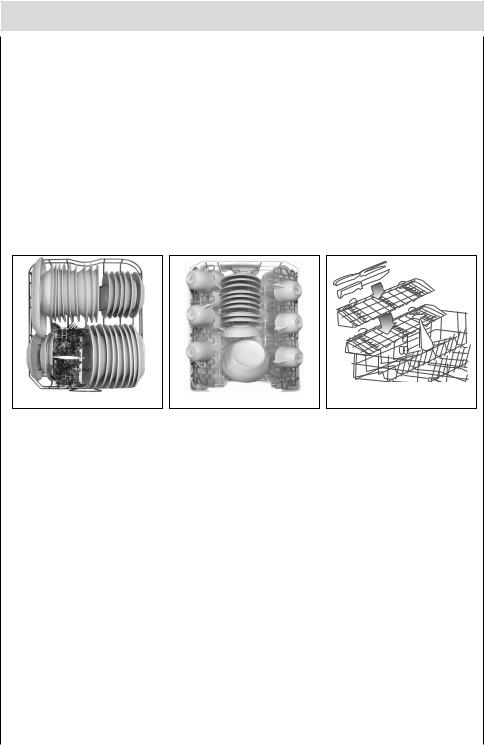
en
Information on comparability tests implemented in compliance with
EN 50242
Appliance loaded in accordance with standard specifications.
Example of loaded dishwasher: See Fig 1 , 2 and 3.
Capacity: 9 place settings
Comparability programme: Light wash
Rinse-aid setting: 5
Detergent: 25g+5g
Fig.1 |
Fig.2 |
Fig.3 |
Height-adjustable top-basket must be inserted in the uppermost position.
If the comparability tests do not comply fully with EN 50242, e.g., degree of soiling, type of dishes and cutlery, etc., contact the appliance manufacturer before starting the test.
28
